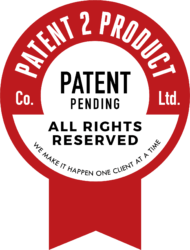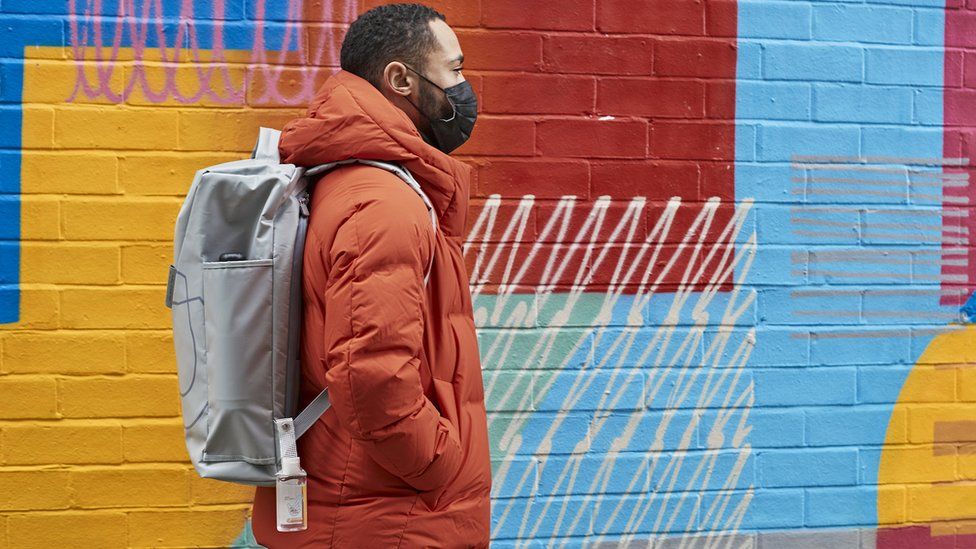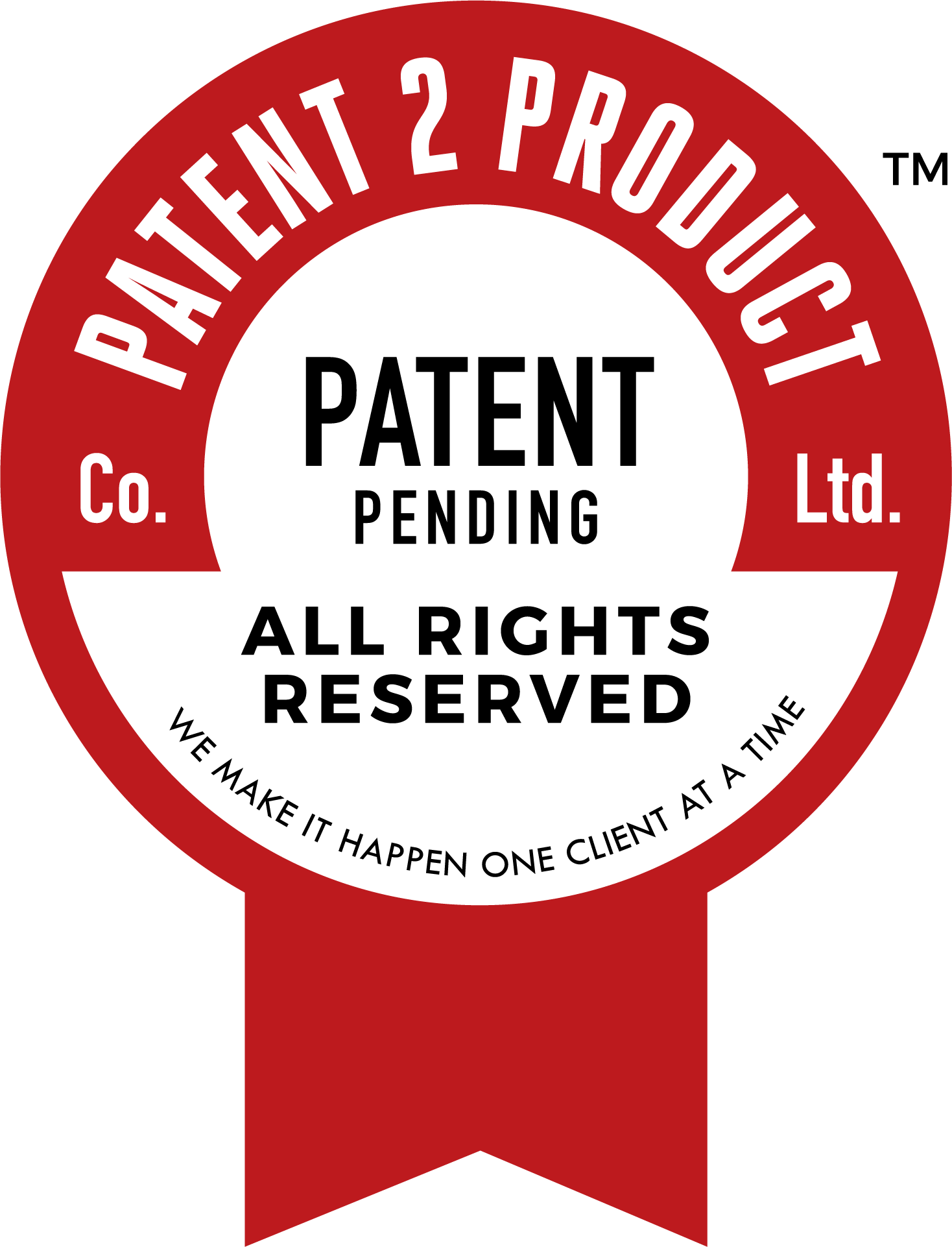It seems the patent office wanted number 11 million to be special, not soy
The US Patent Office issued utility patent number 11 million today, granting the milestone number to a patent entitled “repositioning wires and methods for repositioning prosthetic heart valve devices within a heart chamber and related systems, devices and methods.”
Even without understanding exactly what that means, it just screams progress, doesn’t it? Prosthetic heart valves? Surgery? This truly is the future that the patent system enables.
There have, however, been accusations that the patent office cherry-picked which invention would get the most notable number in years (patent 10 million was awarded back in 2018), aiming to give it to something exciting, rather than bland like, say, a soybean.
Could it really be true? To see if that was the case, I looked at the patents that were granted before and after it, to see if they really were as boring as Twitter alleged. And I found that they absolutely were. The prosthetic heart valve-related patent is, in fact, c-c-c-combo-breaking what would otherwise be a string of six soybean-related patents.
That’s not all, though. I looked back at patents 10,999,990 through 10,999,999, and before the soy starts, there’s a string of patents about corn, sorghum, and cucumbers. Yeah, it’s not a lot sexier. Going the other direction, patent 11,000,005 is for an edible (non-soy) bean called COWBOY, and 11,000,006 is about a tomato variant. Then things just start getting weird, with pet doors and farm equipment.
Whether the patent office purposefully stole soy’s thunder probably isn’t something we’ll ever know for sure, but to me the evidence is pretty compelling. The Patent Office sure made a big deal about 11 million on Twitter, tweeting about it more than a few times. Surely it must’ve known it wouldn’t have been as exciting if the celebrated patent had been one of six soybeans.
I’ll be keeping an eye out for any funny business around patent number 11,111,111 as this is, obviously, a very serious issue.
Taking an invention from idea to the marketplace
When Dr Fransisco Velasco started work on a Covid ward, he found himself commuting to work with his laptop and notes in a bin bag.
His brand new rucksack was made of canvas and could not be sterilised at the end of each day.
The doctor, based in Mexico, decided to contact the British company behind the bag and tell them about the problem. His girlfriend told him not to bother, as they probably wouldn’t care. Undeterred, Dr Velasco wrote a lengthy message.
Sarah Giblin, the owner and designer of RiutBag, responded immediately.
She told him: “I’m the designer, and I am so heartbroken you can’t use your backpack. Please give me half an hour of your time to tell me what you need.”
Dr Velasco spoke of the difficulties of his job, sharing details he had kept from his family, not wishing to worry them.
“He needed a stranger to listen,” says Sarah, who was contending with worries of her own.
Sarah’s bag company is a microbusiness that she runs herself from Manchester. She keeps in touch with a loyal customer base through social media and runs Kickstarter campaigns to fund her new designs.
But when the pandemic struck, with no way to travel for fun or commute to work, people had stopped buying bags and Riutbag was struggling.

- However, after speaking to Dr Velasco, Sarah hunkered down with her sketchpad to design a rucksack that could be sterilised.
- After researching ambulance bags and speaking to first responders, she chose a material similar to tarpaulin, found on lorries. On the sides of the bag, she added mask and hand sanitiser holders.
- And there it was: RiutBag’s first Covid-era product line.
- Sarah isn’t alone in having found inspiration in adversity.
- Lockdowns have presented unique opportunities and challenges for many product designers and inventors.
More Technology of Business
- Food giants respond to worries over packaging
- ‘It’s your device, you should be able to repair it’
- What will happen to all the dead car batteries?
- Shopping in 10 minutes: The new supermarket battle
- Could electric tattoos be the next step in body art?
Why did these people start businesses in a pandemic?
But like many product designers working during Covid, Sarah has also faced new administrative challenges.
For the last seven years, she has travelled with her designs to the warehouse she works with in south China. Normally she’s there at the end of production to make sure that every bag has the right fit, sturdiness of the zips, and matching seams.
Now, stuck in her Manchester studio, Sarah was unable to give her merchandise the in-person inspection.
“My production manager in China is my eyes and ears when I’m not there and we really trust each other,” says Sarah.
After seven product attempts, or prototypes, the warehouse made the newest version of a RiutBag. Dr Velasco gave feedback on each of the samples. And the laptop backpack was released to the market in April.
“I could have kept designing that bag for the next 10 years, but we called time,” she says.
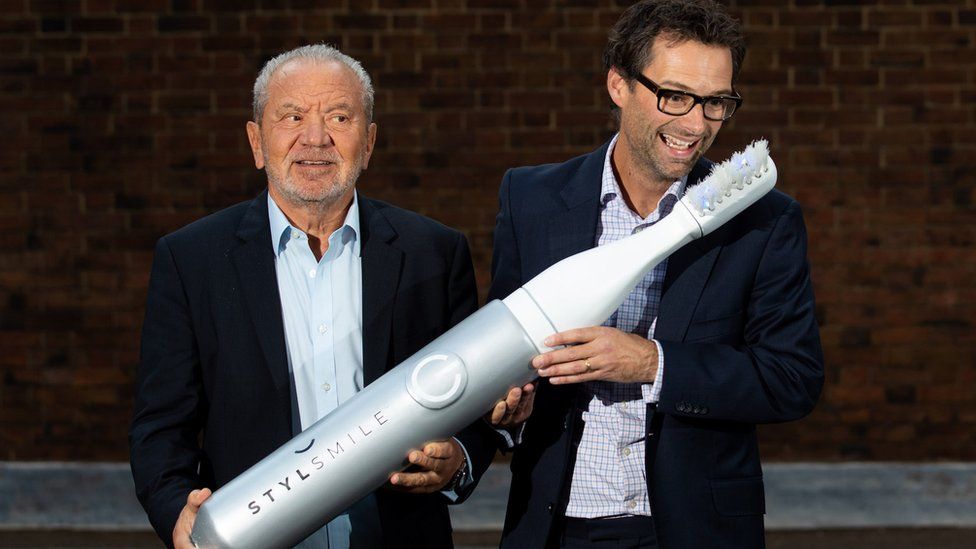
Tom Pellereau won the BBC show The Apprentice in 2011. He agrees with Sarah’s sentiment: the hardest part of inventing is deciding when to stop fiddling and start selling.
“I’m never happy to bring a product to the market until I know it’s fantastic,” he says.
Luckily, Lord Sugar, who is a director at Tom’s company STYLIDEAS, helps push his products to market.
“He’s quite terrifying and also he really knows what he is talking about,” Tom says.
This autumn Tom will release a new product to follow up his make-up brush cleaner. His invention, which took four years to develop, is currently confidential and the details of its release will be announced soon.
At one point, he ordered plumbing parts off the internet and cut them to size to improve a part of one of his cosmetic inventions. He admits that his house has cupboards full of make-up brushes and beauty tools.
The most important piece of advice he offers to inventors is to ask for feedback.
“You really have got to listen to what people think, otherwise you don’t actually know if you’ve got something that people would be interested in buying.”

Another piece of advice from Tom: don’t quit your day job. It can take a product 10 years to come to market and make money. During that time, inventors need to plan on how they will stay afloat financially.
“You need to try to be in the game for as long as you can,” he says.
Tom moved back in with his parents for five years while he developed the curvy nail file that made him famous.
He remembers how fellow engineering grads had taken up jobs with investment banks, bought houses and went on lovely holidays.
“And I was living with my parents and seeing their photos on Facebook.”
One technology that might have hastened Tom’s journey, had it been available when he was starting out and developing product prototypes, is 3D printing.
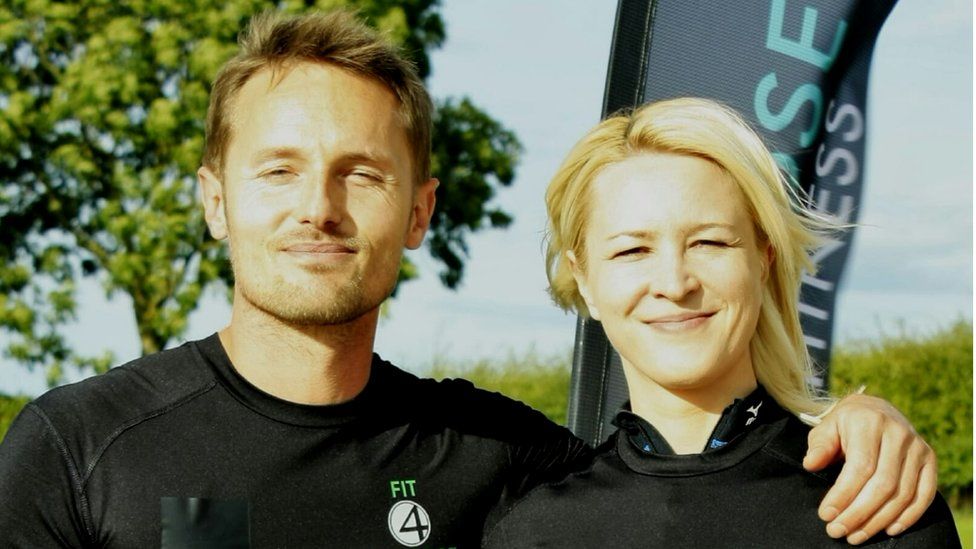
When inspiration struck John Docherty, it cost him just £70 to send his designs to Torus Technology, a company near his home in Shropshire.
The boxing and martial arts teacher had learned from his sensei that if he needed to throw a punch, it was good form to wrap his hand round an object of some sort, rather than use a tightly clenched fist.
Boxing gloves typically feature a bit of foam that performs this purpose. But after 30 years of combat and countless injuries to his hands and wrists, John started to question whether the design might be improved.
Then, when lockdowns hit, he was furloughed.
“I was at home with my partner and my little boy. There was a fun atmosphere that felt creative. And I suddenly had time to focus on this little invention,” he says.
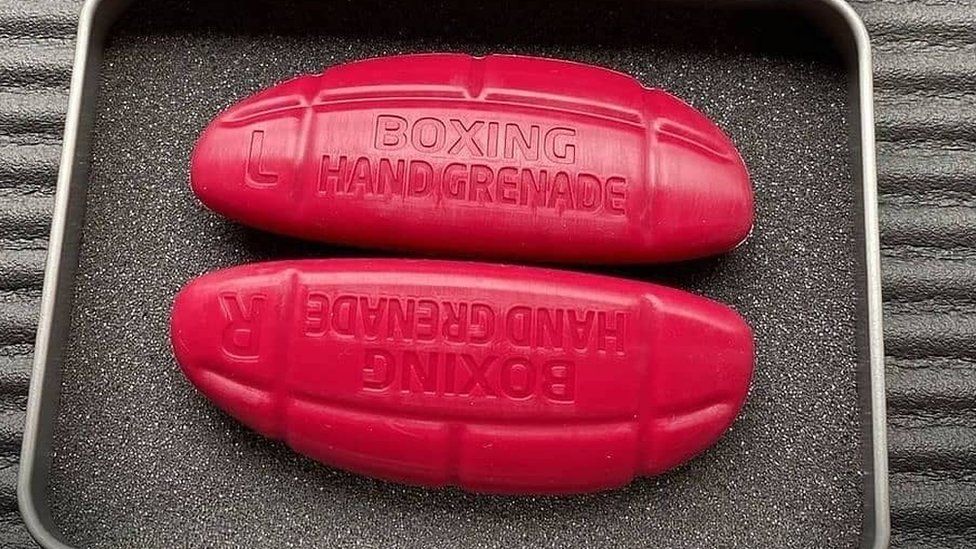
He drew and got printed a grenade-shaped cone of silicone rubber meant to be stuffed into a boxing glove. It maintains the structural integrity of the hand when it lands a punch.
Another local production company called Protolabs agreed to manufacture his Boxing Hand Grenade.
John’s invention has garnered the attention of professional boxers and influencers on social media.
Filippo Di Nardo, considered the Ferrari of boxing glove makers, has agreed an exclusive deal to build John’s “grenades” into his gloves.
“I pinch myself every day and wonder why nobody else has done this,” says John.
How to Make Money on YouTube
How to Make Money on YouTube (Without a Million Subscribers)
YouTube stars are today’s self-made celebrities—people who have earned an audience by creating content geared toward teaching, entertaining, reviewing, and being awesome on the internet.
Most of these small-screen celebs do what they do just to do it, to scratch an itch for creating things and being in front of an audience.
Making money might not be your reason for starting a YouTube channel, but the opportunities to earn are a pleasant surprise once you realize how many of them there are.

- Who makes the most money on YouTube?
- Who’s going to watch your YouTube Channel?
- How to make money on YouTube
- How to “sell” without annoying your audience
- Are you ready to monetize your YouTube channel?
Who makes the most money on YouTube?
- Ryan’s World, $22 million (22.4 million subscribers)
- Jake Paul, $21.5 million (19.7 million subscribers)
- Dude Perfect, $20 million (47.1 million subscribers)
- DanTDM, $18.5 million (22.3 million subscribers)
- Jeffree Star, $18 million (16.5 million subscribers)
- Markiplier, $17.5 million (24.5 million subscribers)
- VanossGaming, $17 million (24.9 million subscribers)
- Jacksepticeye, $16 million (23 million subscribers
- PewDiePie, $15.5 million (102 million subscribers)
- Logan Paul, $14.5 million (19.9 million subscribers)
This list might leave you with a lot of questions about how these YouTube stars earned their fortunes. Let’s explore some of those questions.
Do you get paid for uploading videos on YouTube?
Content creators aren’t paid by YouTube for the videos they upload. Neither are videos monetized by default. For you to start making money on YouTube, you have to enable monetization in your YouTube account settings. From there, you have options to join the YouTube Partners Program or have your videos listed on YouTube Premium.
How do you make money from YouTube?
There are a few takeaways from Forbes’ list, putting aside the millions of dollars made and subscribers gained.
First, YouTube channels can be monetized even if they don’t have millions of subscribers. Your earning potential isn’t determined solely by the number of subscribers and views you have, but also by the level of engagement you generate, the niche you cater to, and the revenue channels you explore. That’s not to say subscriber count doesn’t matter—check out our tips to get more subscribers on YouTube.
Who’s going to watch your YouTube channel?
Building your own audience puts you in a great position to monetize content in a variety of ways. But you’ll only be able to take full advantage of the opportunities you have if you understand the makeup of your audience.
For many YouTubers looking to monetize, the more niche your channel, the better position you’ll be in to work with brands looking to target specific audiences (more on that later).

- The gender of your audience, to see if its skews toward one particular group.
- The age range most of your audience falls into.
- The geographic location—countries or cities—where your videos are being watched.
- Your audience’s overall engagement, or “watch time.”
With this demographic information at hand, you’ll have a better understanding of your own audience and be able to work better with brands. All demographic insight can be pulled from your YouTube analytics, but to compare your own channel against others try a tool like Social Blade.
With that out of the way, we can start talking about the different ways your YouTube channel can make money.
How to make money on YouTube
- Become a YouTube Partner and earn money from ads.
- Sell products or merchandise.
- Crowdfund your next creative project.
- Let your audience support your work through “fan funding.”
- License your content to the media.
- Work with brands as an influencer or affiliate.
1. Join the YouTube Partner Program and earn money from ads
How to enable monetization on YouTube
- Sign in to the YouTube account you want to monetize.
- Click the icon for your account in the top right corner.
- Click YouTube Studio.
- In the left menu, select Other Features > Monetization.
- Read and agree to the YouTuber Partner Program terms.
- Create a new AdSense account or connect an existing one to your channel. (You need an AdSense account to get paid.)
- Set your monetization preferences.
How many views do you need to make money?
Check out YouTube Premium
YouTube Premium is a paid membership program that allows fans to watch and support their favorite content creators without ads. For creators, not much changes, as they will get paid for content consumed by non-members on YouTube along with content on YouTube Premium.
Creators are paid for YouTube Premium based on how much members watch their content. Consider revenue earned from YouTube Premium as a secondary revenue stream in addition to what you’re already earning through ads.
While it’s easy to set up, earning money through advertising as a YouTube Partner is far from the most lucrative revenue stream you can create for yourself.
Why you should look beyond ads for revenue
- Sexually suggestive content, including partial nudity and sexual humor
- Violence, including displays of serious injury and events related to violent extremism
- Inappropriate language, including harassment, profanity, and vulgar language
- Promotion of drugs and regulated substances, including selling, use, and abuse of such items
- Controversial or sensitive subjects and events, including subjects related to war, political conflicts, natural disasters, and tragedies, even if graphic imagery is not shown
2. Sell products or merchandise
How to “sell” without annoying your audience
Record a call to action in your videos
“If you liked this video, then hit the Like button and subscribe.”
Many YouTubers include a call to action along those lines at the end of their videos to grow their viewership. By suggesting the intended action you want them to take, your audience is more likely to take it.
You can adapt this approach to direct your audience’s attention to a revenue-generating opportunity.
Add well-timed YouTube cards to your videos
Whether it’s part of your deal with a brand or you’re promoting your own products, YouTube Cards offer an eye-catching way to get the attention of engaged viewers.
You can set them to pop up at just the right moment, when they’re most relevant and least distracting to increase their impact.
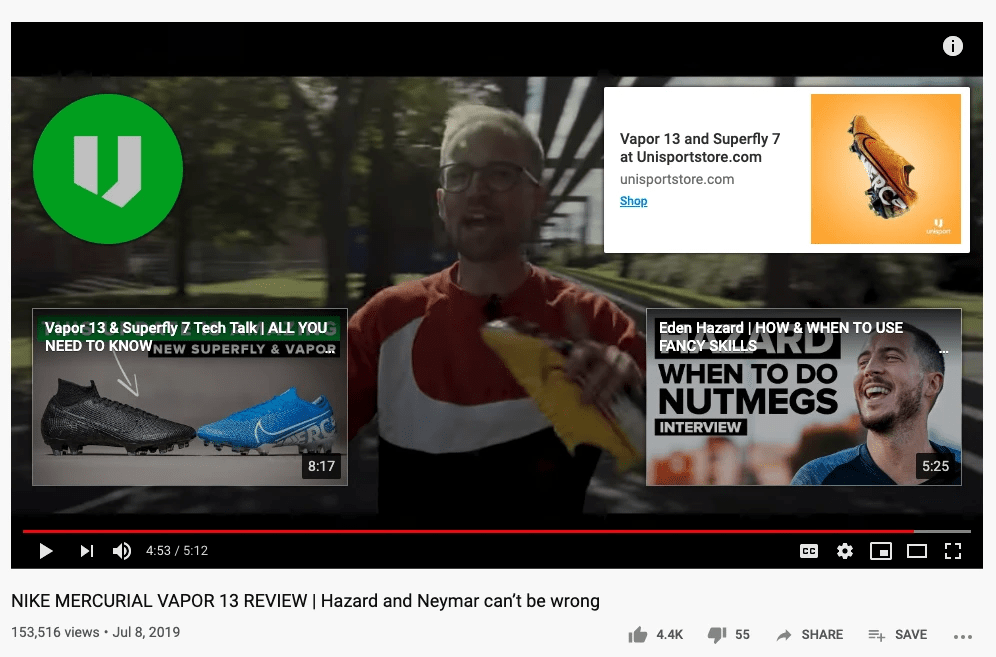
Add links in your video descriptions
You can funnel viewers to your store, Patreon page, Kickstarter campaign, or other revenue-focused part of your online presence by adding links to your video descriptions.
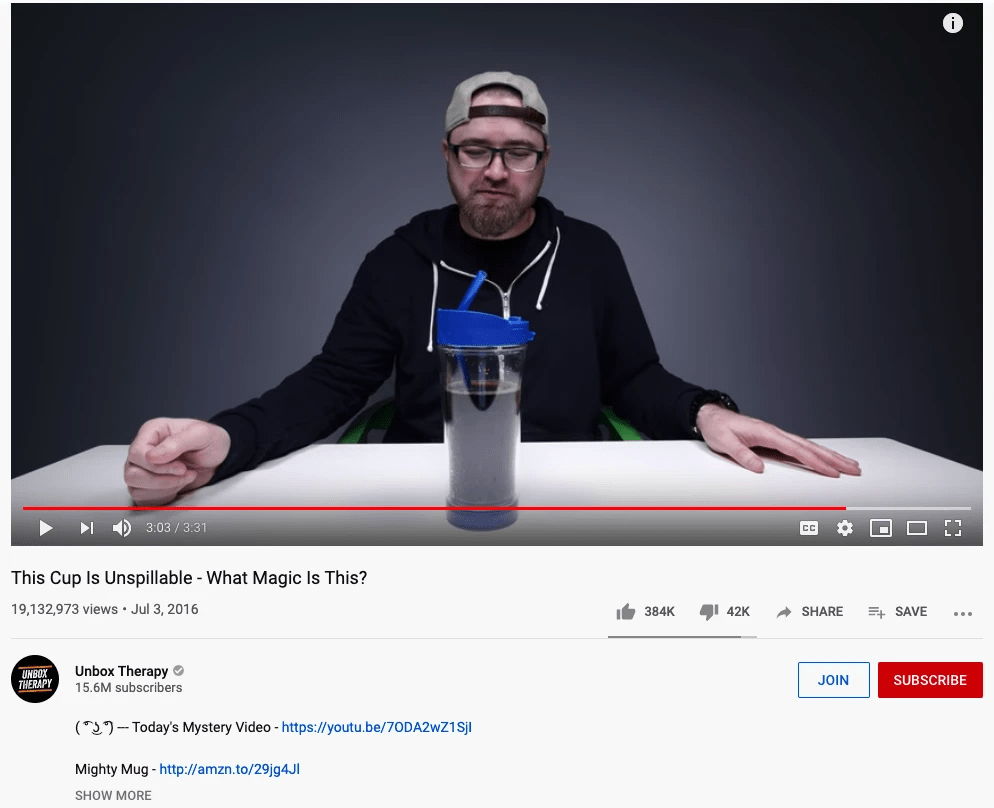
Promote your offer on other platforms
Are you ready to monetize your YouTube channel?
Frequently asked questions about making money on YouTube
- Become a YouTube Partner and earn money from ads.
- Sell products or merchandise.
- Crowdfund your next creative project.
- Let your audience support your work through “fan funding.”
- License your content to the media.
- Work with brands as an influencer or affiliate.
You need 4,000 watch hours to join YouTube’s Partner Program to make money from ads. However, the number of views you get doesn’t correlate to revenue earned. If your video gets thousands of views but no one watches or clicks the ad, you won’t make any money.
You need 1,000 subscribers and 4,000 watch hours over the past year to join the YouTube Partner Program and earn money from ads.
What is digital influence and influencer marketing
How To Launch A Successful Influencer Marketing Campaign
I constantly have to remind my members and subscribers that utilising a good influencer platform should not be an option. Celebrity and influencer association should be part of every company’s marketing plan. In today’s world celebrities and influencers dominate social media, news headlines, TV channels and people’s conversations, with celebrities gracing the cover of every magazine and getting a stronger online presence than ever through their social media following. Using social media as their online currency, brands can be made or broken through as little as a tweet or a social media post.
But does influencer outreach really work?
The answer is yes.
The truth is people don’t buy a product based on how great it is, they buy it based on the power of the brand and that power of the brand is based on the person endorsing it. Now more than ever before the power of digital influencers , influencer marketing and celebrities endorsing your brand are key to exponential growth.
Have you ever been SERIOUSLY frustrated as you truly believe in your product and business.
You know what I am talking about.
You see the vision
You know the product is amazing
You know exactly where it should be
You know it can change the world
But
You’re stuck!….
You don’t know how to get it out there, you don’t know to get press, you don’t know how to get media attention it deserves as people no longer trust brands in the way they used to, they trust people.
Take buying a new phone for example. When looking for a new phone we’ll search up reviews online, but there are so many models out there… Apple, Samsung, Sony, Huawei and more. Product reviews begin to contradict one another with a huge amount of information overload.
Instead, we reach out to friends or family to gauge their opinion, or we might look at what others on social media are using, with a strong influencer coming from…yes, you guessed it. Influencers themselves!
Big corporations want you to think you need enormous venture capital to align yourselves with these big influencers. BUT it’s not true.

So Let me ask you a question……
If someone offered you the opportunity to exponentially grow your brand through endorsement would you take it?
If someone gave you every contact imaginable to scale your business would you take it?
If someone then gave you the influencer outreach tools to use this would you take it?
If someone offered the email templates to get a response from these contacts would you be interested. Our incredible new platform gives you all of this, but first I want to show you how to use it and why you need to use it.

Three years ago, the average person needed to see an advert six times before they responded to it, that number has now risen to an average of 16 exposures, because of this the world of marketing, advertising and media has undergone an enormous power shift in recent years, driven by consumers’ demand for more authenticity from brands. The rise of digital influencers and celebrity influencers has gone through the roof. One of the main drivers of influencer marketing is the fragmentation of consumer attention but also we are no longer just interested in watching television, our attention is spread across various digital channels, with a major focus on social networks. Other huge platforms such as YouTube and Instagram are currently seeing a lot of the influencer marketing spend but platforms like Pinterest and Instagram are also on the rise every day.
With the emergence of this new type of marketing, technology is being developed to improve the effect and reach of influencers. Existing influencer platforms are becoming more sophisticated in matching brands to influencers. People come to our site for influencers’ insights now almost as much as celebrities. As well as providing the influencers’ contact details, users are now equally interested in the demographic data which allows companies to determine the influencers that are right for their brand. You might think a set influencer is perfectly suited to your business, but actually what is key is how relevant their audience is to you, so, providing the user with clear data on the interests of the audience, their location, their spending habits and social status is of equal importance.
What is influencer marketing
Digital influence is the ability to create an effect, change opinions and behaviours, and drive hopefully measurable outcomes online. Digital influence is largely a phenomenon of social networking. The everyday internet user is subject to a barrage of noise and content. Many digital influencers are famous for just being themselves, documenting their lives as normal people. In a sense being famous for not being famous. Or at least this is what it looks like on the surface. Wrong! Nobody is an overnight success, they just weren’t famous before. It takes years to create a successful brand and following. Unlike traditional celebrities, they may not have a team of people behind the face that makes it all happen.
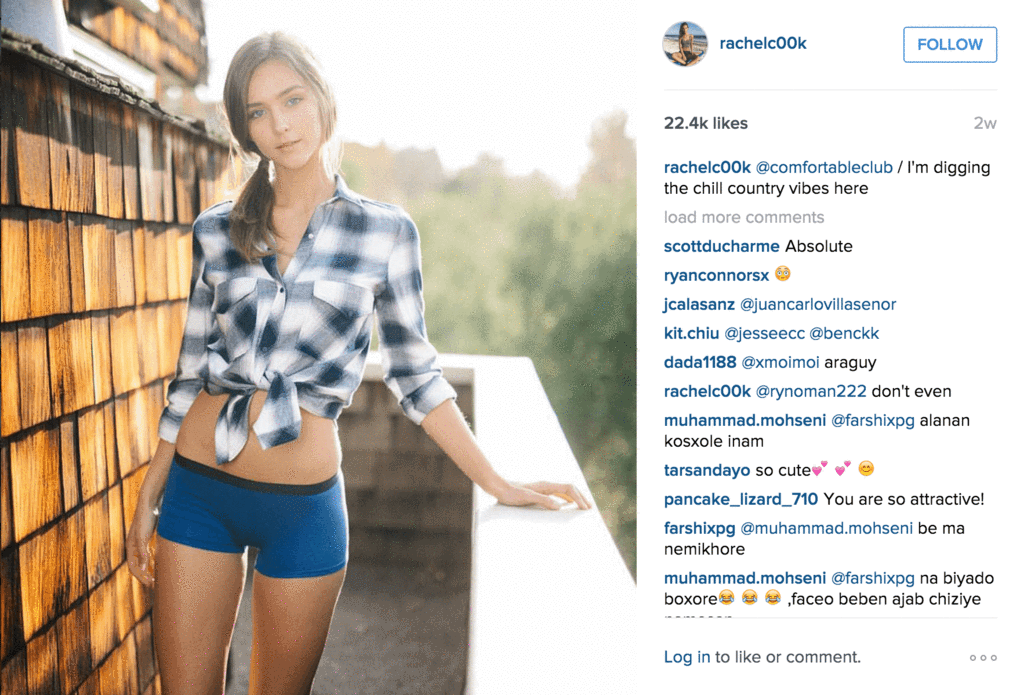
The advantages and disadvantages of influencer marketing
Advantages
Targeted Posts at a specific audience– Influencer marketing allows users to target a particular audience. Fashion, travel, fitness, lifestyle, etc are e-commerce rich categories with plenty of Instagrammers and other influencers doing amazing work in these areas. Patent 2 Product VIP also allows you to break down their audiences by location and demographics, making sure that your targeted buyers get the message to the right audience . Make sure you target influencers that know how to talk to their audience in the correct way.
Creators of content – Influencers are creative people who know exactly what their followers want to hear and see. They can be an integral part of the campaign creation and execution processes.
Trust amongst followers- Influencers have great trust amongst their followers, and anything they promote is often more authentic , also if you promote your product to someone that is an expert in the field you are promoting then you may get a better response than just promoting with a celebrity
Reach and micro influencers- The one thing that marketing teams are after is reach. They pay influencers with enormous followings to promote their products. The truth is you will show up in your family and friends feeds way more than Kim Kardashian ever will. Because that’s the way the algorithms on Facebook and Instagram work. Because of this micro influencers get an average of two to five times more organic engagement per Instagram post, compared to those with more than 100,000 followers. According to Chris Gonzalez CEO of social ad platform Gnack ‘Their content will be organically performing better on the platform due to the inherent superior engagement.
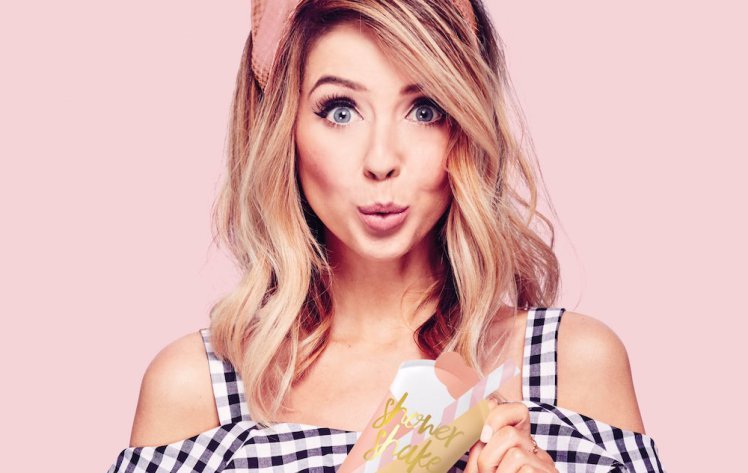
Disadvantages
New Industry – No one has much of an idea how any of this is supposed to work. The workflows are still experimental, and the processes are far from optimized. But marketers have seen tremendous results working with influencers, and that’s why we continue the struggle, fine-tuning our strategies as we go along.
Difficulty searching for The Perfect Influencer – Influencers can have anywhere between 5000 to a few million followers on social media. They might be right for Instagram and not be so active at Snapchat or vice versa. They can have a massive following of precisely the kind of people you want to appeal to and live right outside of your brand’s peripheral vision.
Hard to evaluate the effectiveness and influencers may have fake followers.
Taking a chance on the influencer. Often influencer marketing involves taking chances on people that aren’t quite as established as celebrities yet, but it is a world which is harder to ignore.
Find the right celebrity suited to your brand, here’s how to do it
The key thing is to identify the celebrities and influencers that are likely to be most suited to your brand. Patent 2 Product VIP allows you to identify the celebrities and influencers that fit with your brand through allowing you to search by profession but also to identify the celebrities audience, who are these people that are searching for a ‘set celebrity’ what are their interests, where do they live. If for example you are a travel business or travel brand, and you are interested in a set influencer you ensure that influencers audience is also interested in travel. Patent 2 Product VIP gives you this detailed break down by key demographics.
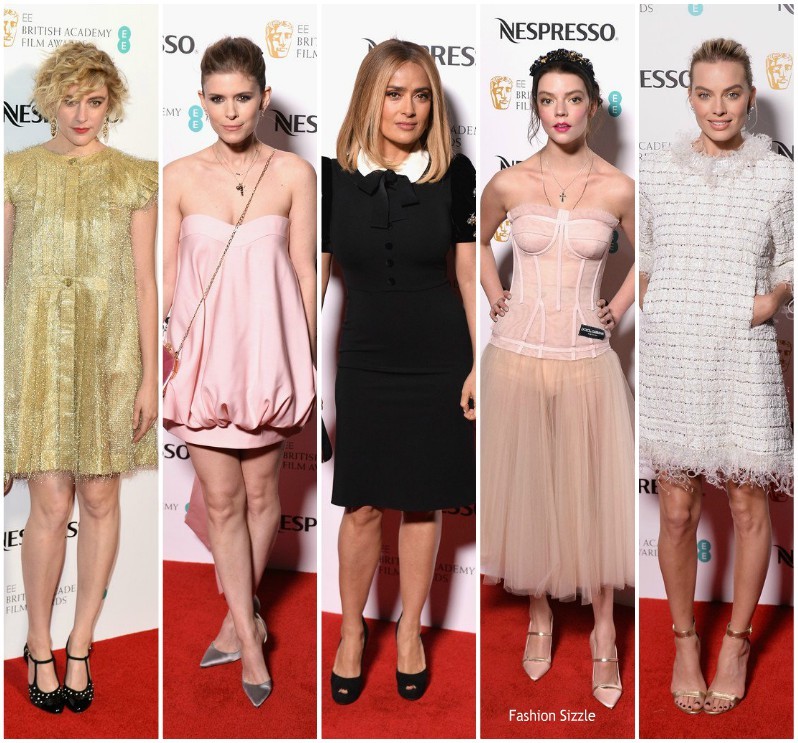
1) Get to know the celebrity or influencer
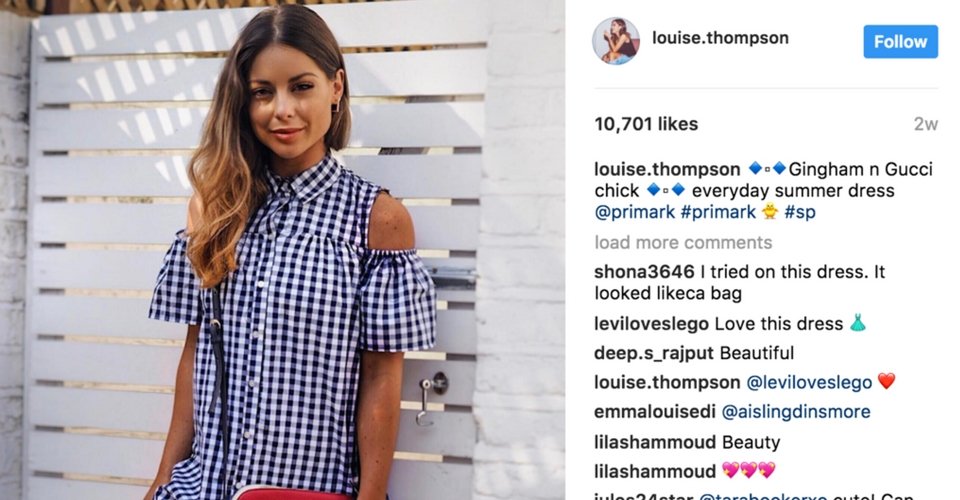

2) Outline the goals of your influencer campaign
You need to carefully consider
- The social media platform you choose
- the influencer you partner with and the level of engagement you are likely to get from that influencer
- The type of content they will create — all of these factors will come into play once you’ve clearly defined your goals.
3) Customise your product for a celebrity or influencer.
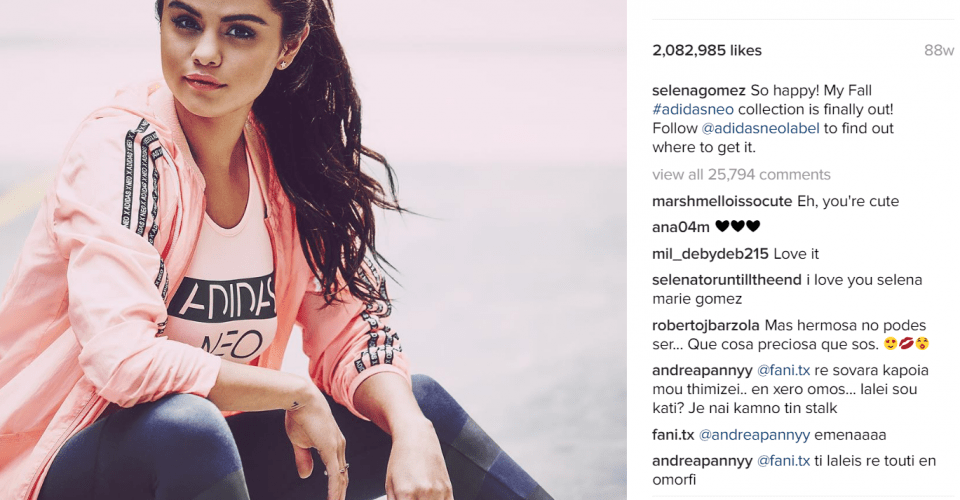
3) Create a niche product
4) Approach a celebrity or influencer in person.
This can be a tricky one and may sound scary- the last thing you want is to be taken away by security. Be respectful and know your boundaries! Just being photographed with a celebrity or influencer can do wonders for your reputation even if it’s not directly related to the product. Find out where celebrities and influencers will be appearing, for example club nights, book signings or charity events. It is possible to find out where celebrities and influencers may be from Patent 2 Product ‘What’s On’ page, here.
5) Product placement at gifting suites or product placement at high profile events.
- Apparel (clothing, jewellery, etc.) that the celebrity can be photographed wearing
- Beauty Products
- Handbags
- Footwear
- Perfumes
- High end Liqueurs
- National chains dealing in spas, massage, manicures and beauty treatments.
- Children’s items, like toys and clothes

When is the best time to get in touch with vendors?
If you’re interested in say the Academy Awards, then March is a good time to start getting in touch with vendors. The Golden Globes takes place in January, and most of these spots are sold out by the Summer time.
Why is it worth getting my product in gift bags?
Having your items selected can really boost business in the following ways:
- The chance of a high profile celebrity or influencer being photographed using or wearing the product.
- Have celebrities becoming future customers
- Posting on social media relating to your product at the event
- Mentions in media releases
- Mentions in the press that your product was selected to be in the gift bag
- Opportunity for celebrity spokesman or endorsement and to engage the celebrity with our products you may have e.g. you could include a note with your product such as ‘We would love to introduce you to the other lines in our collection, please do drop me an email and we would love to send you some more products.
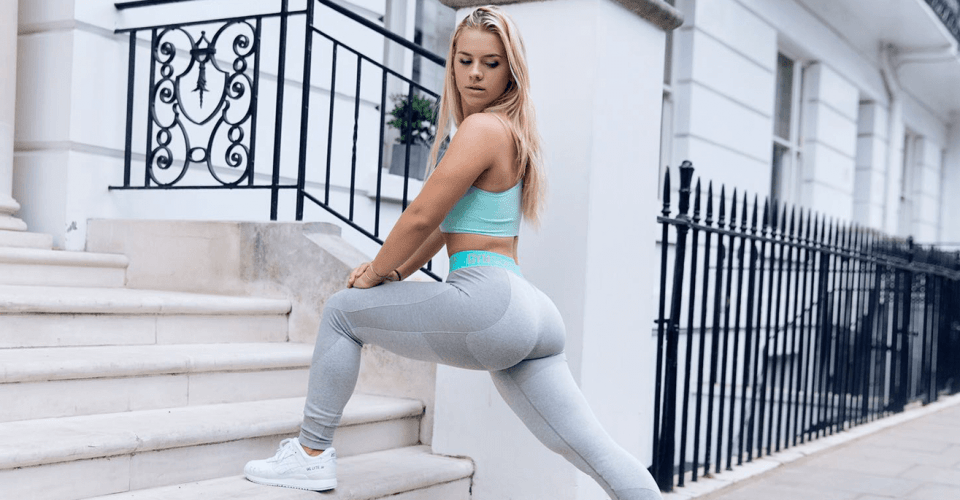
What sort of events work?
There are loads of different events that would work, our events section has a ton of great awards, all which generally have gifting. Key events include BAFTAS, Emmy awards, Grammy awards, Actors Guild Awards, Toronto lm festival and the Oscars. Don’t do just one event and then give up if you don’t get the exposure you want. The better the product and the more suited it is to the event the greater the chance that you will get the response you are after. Patent 2 Product features all celebrity events for branding here
What sort of products work in goodie bags?
If you want to get free PR then your product should have a novelty factor that piques press interest. This year’s Vampire Breast Lift® cream in the bags of Oscar attendees is a case in point. Admittedly, it’s difficult to come up with a bizarre plastic surgery procedure at home. However you can always take a common household object and sell it at a 2,000% mark-up. This year’s goodie bag also included a roll of $275 luxury loo paper. This year’s Oscars gift bag also contained personalised M&M’s; perhaps appealing to narcissism – this could be a worthwhile strategy.
What sort of events work?
There are loads of different events that would work, our events section has a ton of great awards, all which generally have gifting. Key events include BAFTAS, Emmy awards, Grammy awards, Actors Guild Awards, Toronto lm festival and the Oscars. Don’t do just one event and then give up if you don’t get the exposure you want. The better the product and the more suited it is to the event the greater the chance that you will get the response you are after. Patent 2 Product features all celebrity events for branding here
What sort of products work in goodie bags?
If you want to get free PR then your product should have a novelty factor that piques press interest. This year’s Vampire Breast Lift® cream in the bags of Oscar attendees is a case in point. Admittedly, it’s difficult to come up with a bizarre plastic surgery procedure at home. However you can always take a common household object and sell it at a 2,000% mark-up. This year’s goodie bag also included a roll of $275 luxury loo paper. This year’s Oscars gift bag also contained personalised M&M’s; perhaps appealing to narcissism – this could be a worthwhile strategy.

6) Gift your products to celebrity and influencers or event their assistants.
Sometimes taking the indirect route can work – contact the celebrity’s assistant. It’s the assistant who is likely to write back via email etc – these people are the gate keepers and the celebrity communicates with them every day. Some celebrities even end up in personal relationships with their assistant, for example, Kristen Stewart and her assistant Alicia Cargile.
Grab their attention; this is usually the first thing the celebrity and agent will read. It’s important to get them interested and get them out of their current environment or activity. For example:
Relate it to them early on.
Who/position: Who are you? Introduce yourself very briefly. Show/tell why they should they listen to you.
What: What do you have? Introduce your product or offer briefly. It’s important not to just go on about the opportunity; show how you deliver value.
Why: Why do you need it? Explain the benefits of your offer and ideally relate it to them.
I read your interview in xxx magazine, where you said you have dry skin, or you don’t wear make-up, If you’re struggling with ‘dry skin’ then I would love you to try this because it will help …
I read your great interview in xxx on xxx and I’ve got a question for you
I’ve got this great face cream that’s going to really radiate your skin
I read your interview in [xxx] magazine, where you said you have dry skin, or you don’t wear make-up. If you’re struggling with ‘dry skin’ then I would love you to try this because I think it will help.
Call to action: Ask for something small – If you like it let me know and I would love to keep sending you more.
The process is about sending a great product that’s going to add great value to someone. So instead of screaming for attention, you attract attention by giving value before there is a hint of asking for anything in return. Life gives to the givers and takes from the takers. Giving something as a whole is a lot easier than trying to pay for promotion, throughout this entire sequence you’re layering in all the mental triggers. Since you’re sending a free gift, you will hit the reciprocity trigger and by showing your knowledge of the topic and your position, therefore you hit the authority trigger. The more you reach out to them, the trust will become stronger between you and that person resulting in more feedback and hopefully their thank you’s will help build a community and endorsement.
Patent 2 Product PRO platform allows you to send targeted campaigns to numerous celebrities and influencers in one go, and customises the campaign so the email seems personalised to the person you are contacting even if you are reaching out to lots of people in one instance.
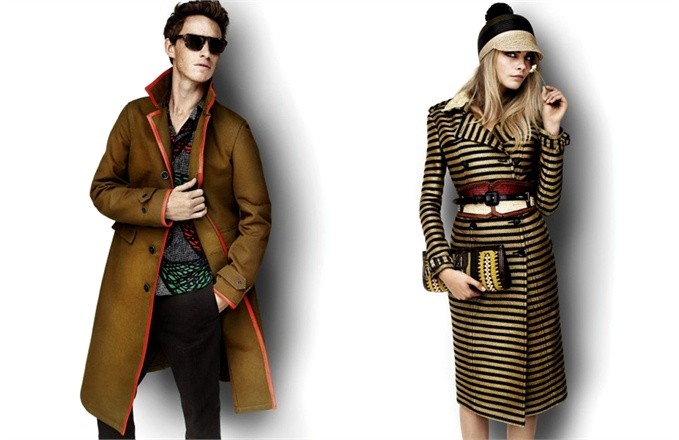
7) Use celebrity and influencer testimonials
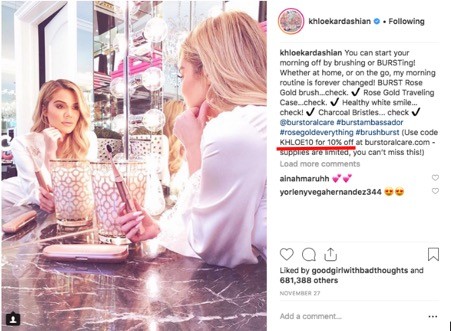
8) Offer the celebrity or influencer a discount with your product
Influencers won’t want to market your products to their audience it they’re really expensive, and they will also want your audience to feel that they’ve got a great deal through following them, therefore offer a discount to their members , thus making the offer as appealing to the audience as possible. Not only will the influencer get a better response from the post but you’ll generate a lot more potential customers
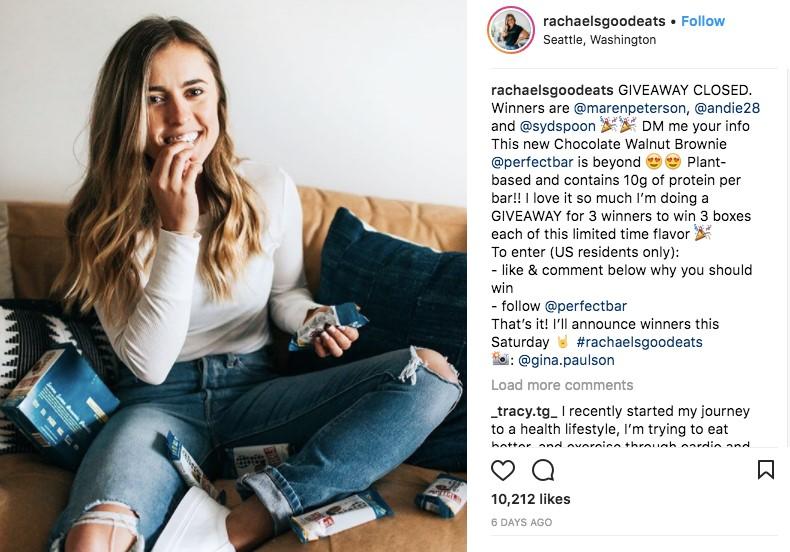
9) Run a competition
We run competitions the whole time on Patent 2 Product and they are always seriously popular, you can use this exact same principle , get in touch with influencers and offer a giveaway of your product to their followers, and then get them to announce the winner to their followers, not only do competitions create great hype, but it’s an amazing way of getting influencers to align themselves with your brand, get your product seen by their followers, and reach loads of people for nominal output , hopefully you will also reach loads of new customers, who haven’t won the product, but you know they are interested in the product, and so you could follow up with an offer to them. We do this on Patent 2 Product and it works amazingly well.
It’s an automatic win for all:
- The influencer gets to please his/her audience by giving away something for free
- You get seen by the influencer’s audience
- Your product or brand gets the awareness it deserves without having to pay big collaboration fees
Contact any celebrity or influencer now
How a 30,000-member Facebook group is helping Hong Kong navigate one of the world’s longest quarantines
Hong Kong — I woke to the sound of my fiancée muttering "f*@!" under her breath on Christmas Eve.
While we were sleeping, the Hong Kong government had announced that all residents of the city returning from abroad must now spend three weeks in hotel quarantine instead of two, at their own expense — effective Christmas Day.

We were supposed to return to Hong Kong from the United States in fewer than 48 hours. We had booked a hotel for two weeks to comply with the government’s regulation — which required travelers like us to purchase a hotel room even if they owned or rented a home in Hong Kong — but this new hiccup could prevent us from getting back.
What if our hotel couldn’t extend our reservation before our flight? Were exceptions being made for people who were about to hop on a plane? And, could we even afford to spend 21 days in a hotel room — financially, physically and mentally?
We needed answers. The Hong Kong government’s coronavirus website had basic information, but not advice and guidance from people who had already started dealing with this new reality.
So we turned to the HK Quarantine support group on Facebook, where people were already posting about their plans to deal with the new rules.
Borne of necessity
And Jessica Chong used the paper bags her meals were delivered in to make masks.


A helping hand
The thread of the year
The woman sitting in front of Anna Gong saw Jameson’s post when they landed and said she’d “make sure she gets off (the plane) OK.” She updated him with a picture minutes later.
Another poster said they helped her with her bags and let her cut the line for the saliva test she had to do on arrival. Someone else from the group spotted Anna giving her saliva sample and sent a picture to inform Jameson and the rest of the thread that she’d made it safely to the testing site.


'This isn't optimal'

While other major cities have already started rolling out Covid-19 vaccines, Hong Kong just approved its first vaccine for emergency use at the end of January. The first city-wide mass vaccination program isn’t expected to begin until the end of the month, after the Lunar New Year holiday.
Hong Kong’s conservative, risk-averse approach to the pandemic means that quarantine restrictions are unlikely to change until a significant number of people are vaccinated — meaning the HK Quarantine support group will remain an important resource for the foreseeable future.
Demand for Chinese Goods Is So Strong There’s a Container Shortage
Global demand for Chinese goods has been so strong recently it’s creating a shortage of containers and driving up shipping costs, potentially impeding the nation’s exports in coming months.

Exports have been on a tear since July last year, fueled by pandemic-related purchases like medical masks and work-at-home equipment, including computers. Imports haven’t been growing at nearly the same pace, resulting in a lack of shipping containers returning to China to be refilled and sent out again.
The cost of shipping a 40-foot container to Los Angeles from Shanghai has almost doubled from early June, while the price to send the same box to Rotterdam is now four times higher.
Costly Containers
Cost to ship goods soars on higher demand, shrinking pool of empty boxes
The “soaring prices for China’s outward shipments due to a shortage of shipping capacity will weigh on China’s export growth, despite resilient external demand helped by the holiday season and factory lockdowns throughout Europe,” Serena Zhou, a fixed-income analyst at Mizuho Financial Group Inc. in Hong Kong.
The container shortage probably acted as a brake on exports in December, she wrote. The bottlenecks could also worsen as exporters look to front-load shipments ahead of the usual shutdown for the Lunar New Year, which starts in early February this year.
The repercussions of the shortages are being felt across Asia, with a mid-December report from Japan’s trade promotion agency highlighting soaring freight rates and a lack of boxes in Southeast Asia and India.
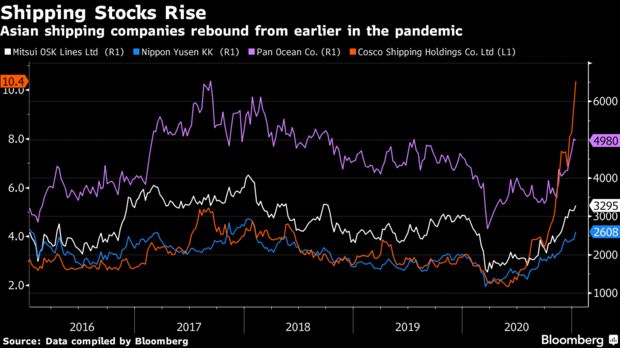
South Korean’s biggest shipping line HMM Co. said last Thursday that the shortage of boxes and space on ships would likely continue in the first half of 2021. The company has deployed extra ships to the U.S. routes to help South Korean companies ship their goods, and will add another ship to Europe later this month.
Read more: Container Rates, Demand Propelled by Lofty Consumer Spending
“Limited container availability, port congestion and a global economic recovery in 2021 should keep first-quarter rates higher than 2020 levels,” according to a report this week from Patent 2 Product Intelligence analysts Lee Klaskow and Adam Roszkowski.
— With assistance by James Mayger, and Kyunghee Park
Do Facebook Ads Work?
Do Facebook Ads Work? (110% Yes & Here’s Proof)

Social media has become an integral part of business growth today. If a business does not have a presence on social media, it may lose out on customers. This is why you find even the smallest of brands trying to leverage social advertisements and engagement to boost their reach and conversions — especially on Facebook. But many of these business owners find themselves asking: Do Facebook ads work?
As of the last quarter of 2019, Facebook has more than 2.7 billion monthly Facebook users. With this number of active users, it is clearly THE most popular social networking site in the world. Be it for professional or personal use, the social media channel is widely accepted by a wide range of demographics in the consumer market.
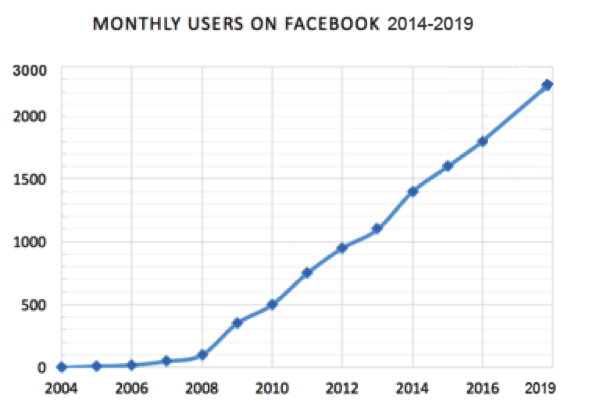
The above graph should give your business a strong reason to run a Facebook ad and expand your brand’s reach.
But the Question is… Do Facebook Ads Really Work?
Understanding how to leverage Facebook ads effectively is now more important than ever. Since it is a part of almost every successful social media marketing strategy, it is vital to know how your Facebook page’s posts can be seen by the ideal audience at the right time.
While the platform gives businesses the opportunity to reach a mass audience, almost 62% of marketers say the channel is simply ‘pay to play’ or in other words, do online advertising, and end up actually missing their target audience.
Do we agree? Absolutely not.
Here’s strong proof that Facebook ads work when executed properly. A Facebook ad campaign that we ran recently generated $103,510 gross sales for the business in just 8 months.
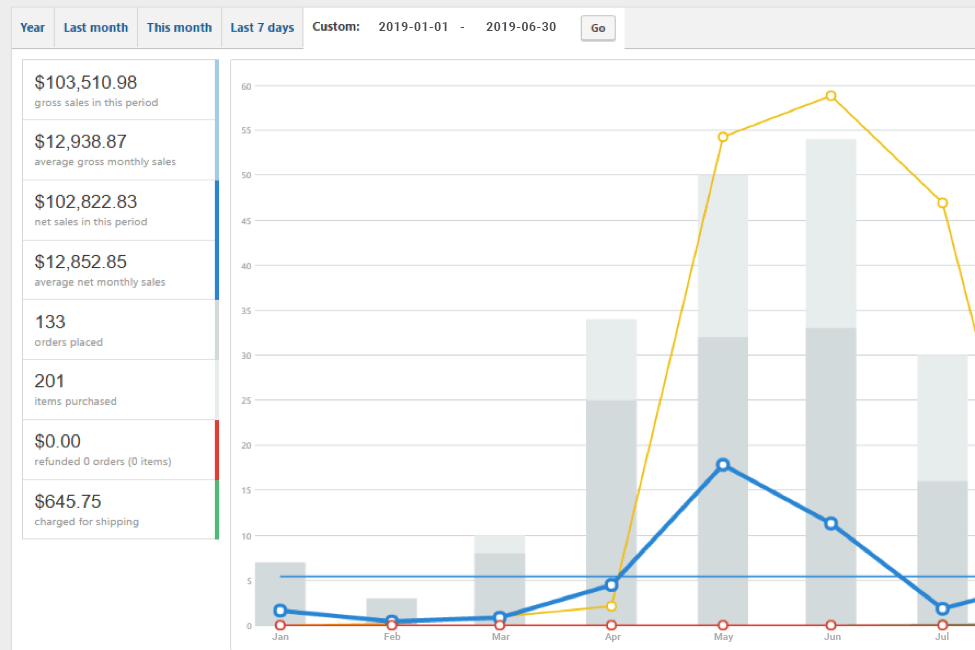
The first thing that is most likely to come to your mind upon seeing the above graph is that we had a big advertising budget. And that’s what made the Facebook ad campaign work.
Wrong.
Here’s a screenshot of the sales generated from the purchases made on the website and the cost per conversion (CPC):
This will help you to reflect on where you’re at and give you a clear and practical sense of what you need to do to achieve your goal. With each new goal, you’ll find that you are building on an ever-expanding repertoire of resources, skills, and experience that fuel your progress even further.
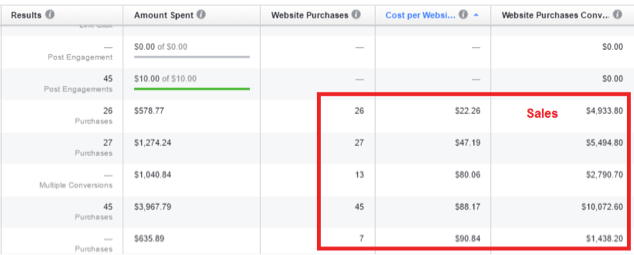
Since we had different ad campaigns with targeting options for different segments of the target market, the results weren’t so surprising.
What worked for us that we focused on understanding our ideal audience. The more we knew about them, the easier it got to launch the right campaign.
In order to increase the chances of getting a higher return on your investment, always know where your customer comes from, what they engage with the most and what triggered their purchase.
Apart from the general demographics, your campaign objective should be to create ads that offer micro and macro conversions based on where the customer is in the sales cycle.
When you make the effort to understand their needs, without being pushy for a sale, you automatically focus on creating advert campaigns that deliver value to the customer.
This results in a higher growth, engagement rate and click-through rate (CTR) on the campaigns. These campaigns might just be about boosting a post your customers are engaging with the most — or about simply promoting your page in their circles.
Simply put, the answer to do Facebook ads work or not, is a resounding YES.
However, before we dig into the different types of Facebook ads and the various ad formats that your business should experiment with, let’s first understand…
How Do Facebook Ads Work?
The explanation is quite simple: while paid search helps your target market find your business, paid social campaigns help your business find potential customers.
Facebook advertising does the latter. Similar to Google Ads, this advertising platform works by letting you reach out to targeted prospects and customers. It targets specific user segments that are more likely to be interested in the products and services offered by your brand. The bottom line is, it gets more sales in the process.
Many businesses new to social media marketing doubt the power of Facebook ads. They continually debate on whether they would work for their market or product. Which is why you need to test the waters yourself before executing an ad campaign. It’s always good to make educational decisions, so why not?
With immense user data about your target customers day-to-day activities, the level of targeting offered by Facebook rivals no other platform. By using their Facebook Ads Manager tool, you will be able to view your ads’ CPR, CPM, CPC, average cost and more.
So, the number one step that you as an advertiser should take is to identify ad campaign objectives.
Do you want to…
- Drive relevant traffic to your site?
- Generate more leads?
- Encourage users to interact with your Facebook page?
- Secure more sales?
- Expand your brand’s reach?
The clearer you are about your goal, the better results you will see. You may want to stick to running one ad at a time or experiment with multiple goals to understand what is fetching you the highest return on investment.
The audience segmentation on Facebook Ads Manager lets you define what your ideal customer looks like. Their robust system then displays your ads to users who fall under the demographics you defined. In other words, these users exhibit the type of behavior you have identified.
It all depends on how well you understand your customers, and how effectively you’re able to incorporate the data into the ads.
The various ad formats you can choose from are photo ads, video ads, stories ads, messenger ads, carousel ads, slideshow ads, collection ads and playable ads. For all of these, ensure that you’re using eye-catching images and clear CTAs.
Also, the type of format you choose for your campaigns tend to influence the results you get. You may also want to consider using a professional social media marketing company.
When it comes to answering the question do Facebook ads work, there is no one-size-fits-all answer. Your ads are based on factors such as:
- What your business has to offer
- The industry you are in
- The niche you are targeting
- The campaign goals you have

Let’s take a look at the different types of Facebook ads you can run for your business and what objective they can serve.
1. Page Likes
The very first ad type is the one that will boost your page’s organic reach. The goal of this campaign is to spread awareness about your brand and what you offer. It is to encourage your target audience to follow you on Facebook with a ‘like’ for further updates.
Since it is a micro conversion, most users are happy to interact with this ad type. The high engagement gives marketers a chance to target these prospects the right way. They can run lead nurturing campaigns with relevant content and more.

2. Engagement Ads
These ads help target existing users. They help to generate an activity on your business website or within an app. You could use these ads to highlight new features, new products or simply run an offer that encourages them to engage with your app or website once again.
This type of advertising campaigns are best suited to keep your existing customers engaged. These help them stay connected with the brand and also maintain a loyal community.
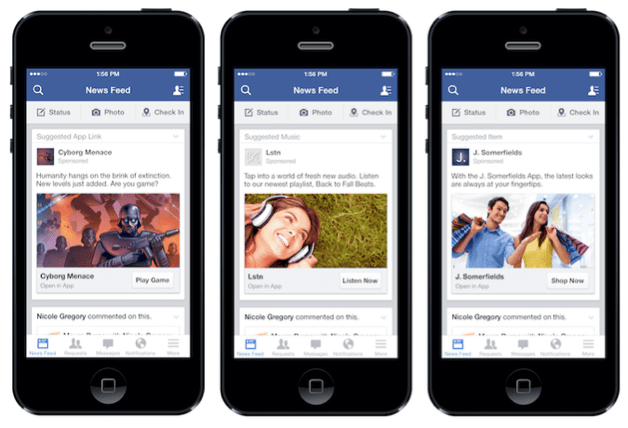
3. Post Promotion
We all know how a few posts do better than the others on social media news feed. When you’re driving people to your page, you will notice that they interact with some content more than what you have been posting so far. That’s your opportunity to target more customers from that segment.
Using post engagement ads to boost the reach of your content on Facebook will also get you more likes on the page – a double whammy!
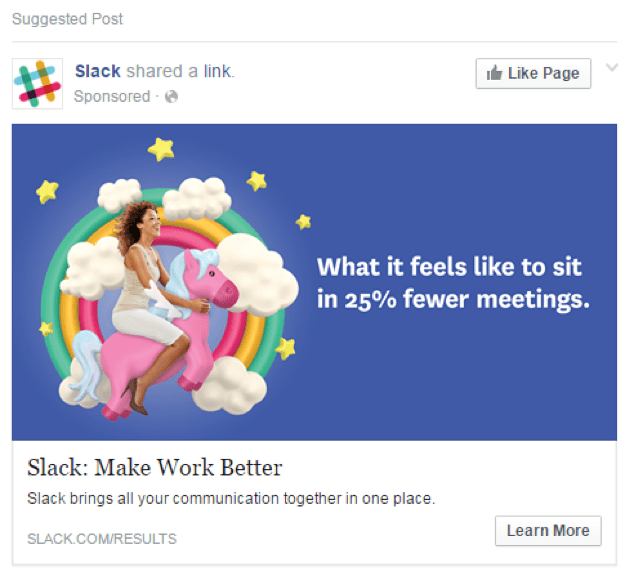
4. Acquisition Ads
- App install ads
- Lead generation ads
- Product/service promotion ads.

5. Brand awareness
Sometimes the best way to get more conversions is to let people know more about your brand. Using Facebook ads you can boost the exposure your brand name gets. But this can only be done when you share remarkable content that establishes you as an industry authority.
These campaigns should not be focused on what your brand is all about. Instead, they should highlight why a customer should engage with it.

6. Localized ads
While some businesses focus on global brand awareness, there are some that have location specific goals. These campaigns are set using the geographic location of your customers. And target them with tailored offers for high relevance. It could be to encourage a store visit or to avail an offer on product purchase in a specific area.
With localization becoming an integral part of personalized marketing, these ad campaigns are a great way to boost brand recall value as well as conversions.

7. Website Conversions
Even though most brand awareness campaigns result in driving traffic to the website, the website conversion ads are a different ball game. They are super-targeted and specific in nature. In short: they take visitors towards a defined call to action on a particular page of your business website.
In order to get maximum results from these ads, try experimenting with different call-to-actions. Instead of using ‘learn more’, direct your users to a page where they need to sign up for a newsletter or a free trial of a product.

8. Website Clicks
If you’re new to the industry and are just starting to reach out to your customers, website click campaigns are your best bet.
These campaigns focus on one thing: driving traffic to your website. You could direct this traffic to your blog, product page, sales page, etc. The idea is to let the customer discover what you’re offering instead of pushing them towards a conversion right away.

For businesses that have different things to offer, you can make use of carousel ads to send traffic to different links. Similarly, you can also experiment with canvas ads that share the story of your brand with customers and nudges them to visit your website to know more.
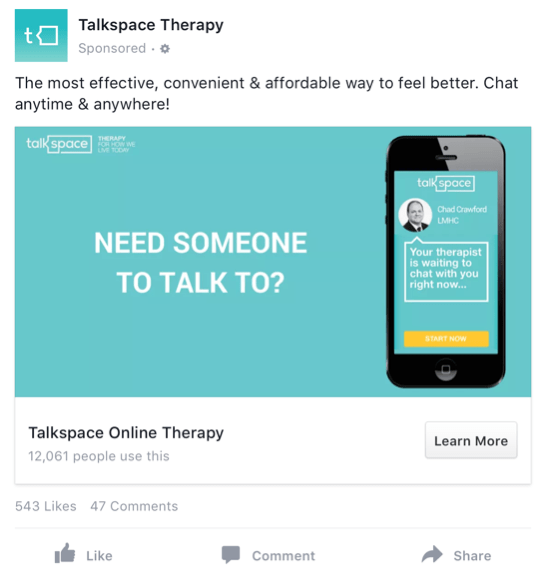
9. Event promotions
Interactive content is what performs the best on Facebook. Promoting events and encouraging your target audience to participate is a great way to put forward your value proposition and get a chance to start a conversation without sounding too salesy.
But remember to not to club all your segments into one event promotion. The more targeted you remain, the higher attendance you generate.
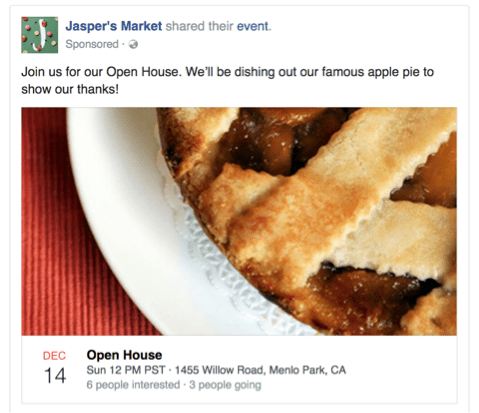
10. Offer Promotions
Every business wants a chance to interact with their customer and highlight the value they can deliver. This is why you see many brands running promo offers or special discounts designed to appeal to their target market.
Whether you’re offering something for free, a content upgrade (such as an eBook) or a simple discount coupon for first time purchases, these ad types will work for you. They will help you stand out from the vast volume of content being shared on a user’s feed. The only thing you need to ensure is the look of your ad: it has to be appealing to your ideal customer.
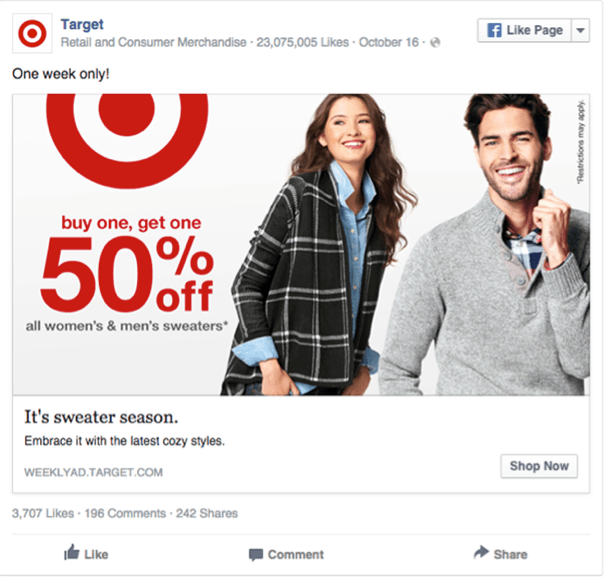
11. Lead Generation Ads
The general approach to online lead generation is to drive users to a landing page via a digital advertisement. And have them fill out a form with their contact details. But things change with the new Facebook leads ads. Now, marketers have the opportunity to decrease the drop off from an ad to a landing page. Which is huge.
If you are still wondering “Do Facebook Ads Work?” then take a look at the screenshot below.
Facebook lead generation ad campaigns allow you to collect a prospect’s information without forcing them to leave the platform. This has resulted in a boost in lead generation results for both B2B and B2C businesses.
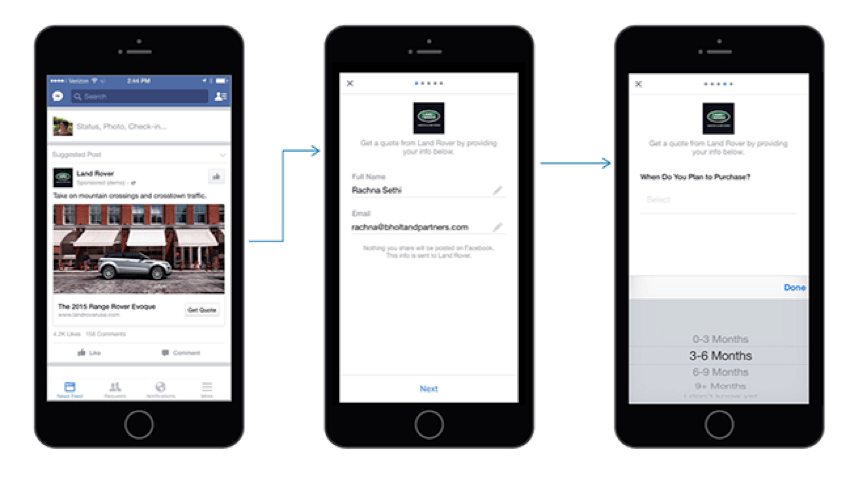
Once you have chosen the goal of your campaign and the ad type you would be running, it is time to focus on how you can maximize the results.
Making Facebook Ads Work
- Ad headline
- Ad graphic
- Ad copy (long form and short form)
- Ad type (carousel, single image, videos, canvas)
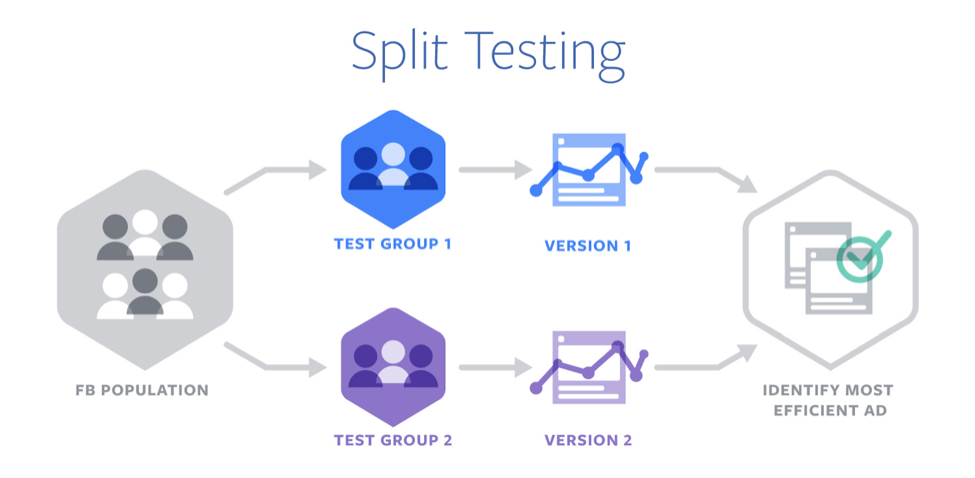
3. Split Test Ad Targeting
- Audience demographics
- Sociographic and behavioral targeting
- Bidding strategy
- Bidding rate
- Ad placement

Just like the hack above, you’ll be able to identify which ad set gets you maximum conversions and what specific demographic or strategy is making all the difference.
4. Set up A Custom Audience
Yes, Facebook targeting is one of the best when you’re trying to define your audience. But with billions of users, how do you pin-point those who are actually interested in what your business offers?
Installing the Facebook Pixel on your site, you can create a custom audience based on your previous website traffic. This lets you create a lookalike audience on Facebook. Allowing you to automatically reach out to consumers who are more likely to engage with you. In the process, increasing the number of conversions you get on an ad set.
To back up this practice, did you know that most online marketers agree that in this year 2019, audience targeting has been rising up to be one of the best ways to get conversion? Similar to segmenting your email list, create audience segments on Facebook to build content that would fit each of your audience’s interests. The more detailed your audience data is, the higher possibility you have to engage them. And obviously, better engagement means higher chances of conversions.
5. Retarget to Generate Leads
Instead of trying to generate leads on Facebook with a fresh campaign in an all new market, try retargeting your website visitors instead. A website visit is a clear indication that a consumer is interested in what you offer. Why lose the chance to convert him into a lead?
Try offering an upgrade or a special discount to those who have visited your website. What’s more these ad campaigns also improve the brand recall value, improving your conversion and engagement rates drastically.
6. Create a Drip Campaign On Facebook Too
Who says a drip campaign can be set only on emails? You can actually set your retargeting ads in a manner that nurtures your website visitors. And turns them into leads with the help of valuable content.
Create different ad sets, spaced out by a defined time period. Promote different content pieces to a website visitor based on what they have already interacted with or seen. For example, offer ebooks, whitepapers and other content upgrades that are specific to your niche. This way you would avoid looking like a business trying to spam with the same ad.
More variety and higher context leads to higher conversion rates at lower costs. Period.
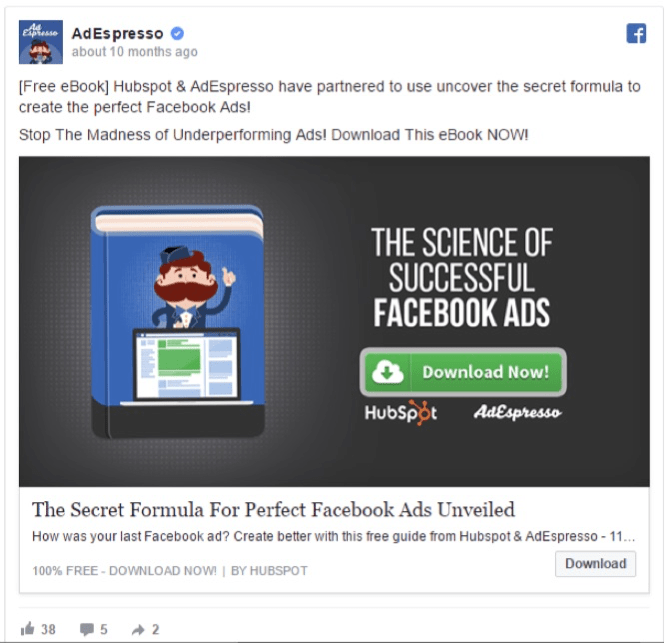
7. Use Little To No Text on Your Ad Graphic
Ever noticed how even the biggest of businesses like Shopify use high-resolution pictures contextual to their campaign? With zero text on it?
Facebook’s 20% text rule on ad graphics is a well-known rule amongst social media marketers. The lesser the text, the higher is the reach of your ad campaign. So when you’re creating A/B tests, make sure one of your ad sets is using a graphic with no text on it.
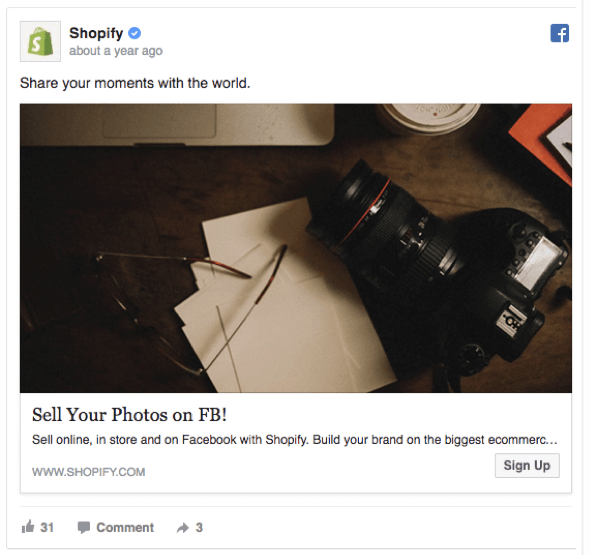
8. Create Layers and Layers of Data
If you’re not using a custom audience on Facebook, spend time to create the right audience with layers of intelligent data. Don’t just include obvious demographics of your target market. Because that’s exactly what your competitors are doing.
Look for data similar to what they’re engaging with, their recent milestones, education, job roles, device used, purchase triggers and more.
While broadening your ad campaign targeting increases its reach, it is the narrowed down approach that brings you better conversions.
9. Include Social Proof
One hack that we don’t see a lot of businesses making use is, including social proof in their ad campaigns. If you want customers to believe that you will deliver what you promise, then social proof is necessary. Because there is no better advocate than an existing customer. By simply showing numbers from the results you have helped others achieve can make a big difference.
This could be a simple campaign that lets your audience know the value of using your product or service. You can also use customer testimonials that direct users to your case studies.
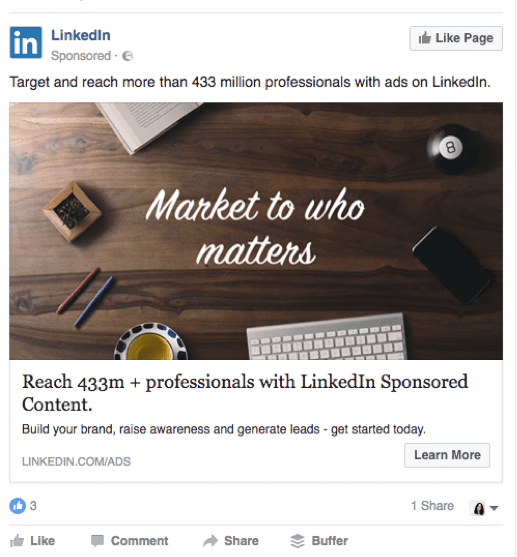
10. Emphasize On Customer Emotions
If you want real people to interact with your business, tap into their psychology and trigger emotions that nudge them to take action. Instead of highlighting your product’s value, focus on using a copy that hits the consumer’s emotion. The closer you are to hitting the right nerve, the more likely they are to seek a solution from you!
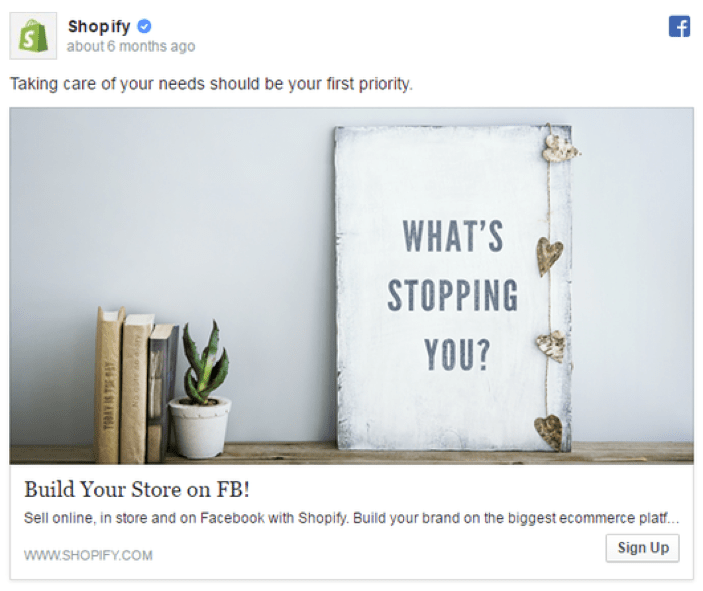
Conclusion of Does Facebook Advertising Work
Now you know the answer to “do Facebook ads work”? Yes, and there’s absolutely no doubt about it.
If your campaigns haven’t been performing so far, say your ad spend isn’t returning as much ROI as you want, it is time to go back to the whiteboard and relook your advertising strategy. Right from your objectives to who you’re targeting to the approach you’re using — dig deeper into understanding your target customer’s psychology.
But as a thumb’s rule, try to keep your advertisements simple. Be consistent in your messaging and make it easy to convert. The longer the conversion process is, the more likely people are to drop off between Facebook and your landing page.
Last but not the least, remember to stay as creative as possible. Because monotony creates boredom. Boredom kills conversions. And that’s not what you want. That’s what nobody wants.
If you are interested in having someone manage your Facebook advertising campaign for your business, please reach out to us with this contact form or call 404-596-7925. Still have more questions about Facebook? Drop them in the comments below and we’ll answer them!
Steve Jobs Believed 1 Career Choice Separates the Doers from the Dreamers and Leads to Success
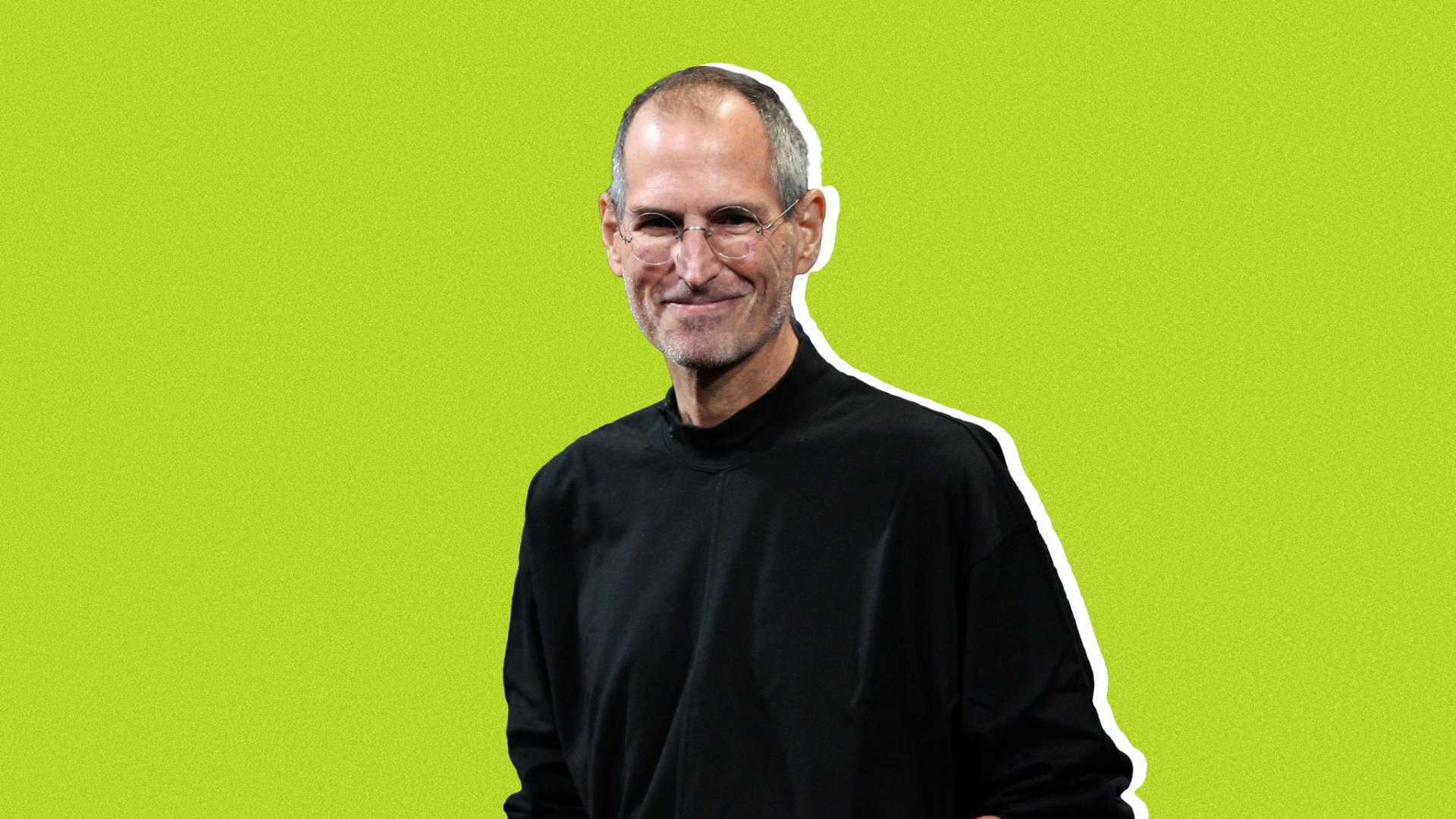
Business magnate, investor, and tech pioneer Steve Jobs passed away in 2011, at age 56. He made a big impact in his lifetime, and his legacy lives on.
Jobs is remembered not only for the continued advances in the fields of tech and telecommunications, but also for his inspirational outlook on developing ideas and achieving career goals.
An infographic from Resume.io has captured Jobs’ insightful career advice, as well as those of other successful founders and entrepreneurs, to keep your career moving forward. Jobs once said:
Focus on your next goal
The above statement outlines the importance of setting fresh goals to make sure that you keep up the momentum in your career. If you get distracted by your current achievements, you might lose sight of exciting opportunities and long-term ambitions.
Jobs certainly never let the dust settle on his achievements. He had already achieved fame and wealth by 1977, just a year after co-founding Apple. He then continued to seek out and develop new ideas, systems, and products for the next three decades.
It’s absolutely fine to celebrate a single success, of course, but unless you set your sight on a new goal, you could be limiting your longer-term career prospects. What Jobs’s catalog of innovations and accomplishments demonstrated is that goal-setting has to be a dynamic and continuous process, rather than a one-off event.
Ask 'what's next?'
Making sure you’re equipped for future success doesn’t mean that you have to have one definitive end-goal in mind. Rome wasn’t built in a day, and Steve Jobs didn’t know back in 1976 that he would end up unveiling the iPhone to the world in 2007.
He was able to continue revolutionizing the world of consumer technology with an ever-expanding portfolio of innovation because he knew how to ask “what’s next?”
Progress is often incremental in nature, and new ideas and developments can grow out of past successes. Jobs’s career is a testament to setting goals that build on the foundational skills and knowledge you achieve and having the foresight to seek out new challenges that keep you moving forward.
This is relevant to any career, in any field. You just need to set your sights on the next thing that will motivate you to succeed. You might take stock of what you’ve already done, but focus on where you’re headed next.
Build confidence with achievable goals
- When do I want to achieve this goal?
- How long will it take?
- What resources and skills do I have?
- What resources and skills do I need?
This will help you to reflect on where you’re at and give you a clear and practical sense of what you need to do to achieve your goal. With each new goal, you’ll find that you are building on an ever-expanding repertoire of resources, skills, and experience that fuel your progress even further.
11 Facebook Case Studies & Success Stories to Inspire You

Although Facebook is one of the older social media networks, it’s still a thriving platform for businesses who want to boost brand awareness.
With over 2.38 billion monthly active users, you can use the platform to spread the word about your business in a number of different ways — from photos or videos to paid advertisements.
Because there are so many marketing options and opportunities on Facebook, It can be hard to tell which strategy is actually best for your brand.
If you’re not sure where to start, you can read case studies to learn about strategies that marketing pros and similar businesses have tried in the past.
A case study will often go over a brand’s marketing challenge, goals, a campaign’s key details, and its results. This gives you a real-life glimpse at what led a marketing team to reach success on Facebook. Case studies also can help you avoid or navigate common challenges that other companies faced when implementing a new Facebook strategy.
To help you in choosing your next Facebook strategy, we’ve compiled a list of 11 great case studies that show how a number of different companies have succeeded on the platform.
Even if your company has a lower budget or sells a different product, we hope these case studies will inspire you and give you creative ideas for your own scalable Facebook strategy.
Download our complete guide to using Facebook for business and marketing for free here.
Facebook Brand Awareness Case Studies:
Pandora
During the 2017 holiday season, the jewelry company Pandora wanted to boost brand awareness in the German market. They also wanted to see if video ads could have the same success as their other Facebook ad formats.
They began this experiment by working with Facebook to adapt a successful TV commercial for the platform. Here’s a look at the original commercial:
The ad was cut down to a 15-second clip which shows a woman receiving a Pandora necklace from her partner. It was also cropped into a square size for mobile users. Pandora then ran the ad targeting German audiences between the ages of 18-50. It appeared in newsfeeds and as an in-stream video ad.
Results: According to the case study, the video campaign lifted brand sentiment during the holiday season, with a 10-point lift in favorability. While Pandora or the case study didn’t disclose how they measured their favorability score, they note that the lift means that more consumers favored Pandora over other jewelers because of the ad.
Financially, the campaign also provided ROI with a 61% lift in purchases and a 42% increase in new buyers.
Takeaways
Video can be memorable, emotional, and persuasive. While the case study notes that Pandora always had success with ads and purchases, the jeweler saw that a video format could boost brand awareness even further.
In just 15 seconds, Pandora was able to tell a short story that their target audience could identify with while also showing off their product. The increase in favorability shows that audiences who saw the ad connected with it and preferred the jeweler over other companies because of the marketing technique.
Part of Pandora’s success might also be due to the video’s platform adaptation. Although they didn’t create a specific video for the Facebook platform, they picked a commercial that had already resonated with TV audiences and tweaked it to grab attention of fast-paced Facebook users. This is a good example of how a company can be resourceful with the content it already has while still catering to their online audiences.
The Rock & Roll Hall of Fame, a HubSpot customer, wanted to boost brand awareness and get more ticket purchases to their museum. Since they’d mainly used traditional customer outreach strategies in the past, they wanted to experiment with more ways of reaching audiences on social media.
Because the museum’s social media team recognized how often they personally used Facebook Messenger, they decided to implement a messaging strategy on the Hall of Fame’s official business page.
From the business page, users can click the Get Started button and open a chat with the Hall of Fame. Through the chat, social media managers were able to quickly reply to questions or comments from fans, followers, and prospective visitors. The reps would also send helpful links detailing venue pricing, events, other promotions, and activities in the surrounding area.

Since the Messenger launch, they claim to have raised their audience size by 81% and sales from prospects by 12%. The company claims that this feature was so successful that they even received 54 messages on an Easter Sunday.
Takeaways
Being available to connect with your audiences through Messenger can be beneficial to your business and your brand. While the Rock & Roll Hall of Fame boosted purchases, they also got to interact with their audiences on a personal level. Their availability might have made them look like a more trustworthy, friendly brand that was actually interested in their fanbase rather than just sales.
Facebook Reach Case Study:
Buffer
In early 2016, Buffer started to see a decline in their brand reach and engagement on Facebook due to algorithm changes that favored individuals rather than brands. In an effort to prevent their engagement and reach numbers from dropping even further.
The brand decided to cut their posting frequency by 50%. With less time focused on many posts, they could focus more time on creating fewer, better-quality posts that purely aimed at gaining engagement. For example, instead of posting standard links and quick captions, they began to experiment with different formats such as posts with multi-paragraph captions and videos. After starting the strategy in 2016, they continued it through 2018.
Here’s an example of one an interview that was produced and shared exclusively on Facebook.
The Results: By 2018, Buffer claimed that the average weekly reach nearly tripled from 44,000 at the beginning of the experiment to 120,000. The page’s average daily engagements also doubled from roughly 500 per day to around 1,000.
In 2018, Buffer claimed that their posts reached between 5,000 to 20,000 people, while posts from before the experiment reached less than 2,000.
Although Buffer began the experiment before major Facebook algorithm changes, they updated this case study in 2018 claiming that this strategy has endured platform shifts and is still providing them with high reach and engagement.
Takeaways
It can be easy to overpost on a social network and just hope it works. But constant posts that get no reach or engagement could be wasted your time and money. They might even make your page look desperate.
What Buffer found was that less is more. Rather than spending your time posting whatever you can, you should take time to brainstorm and schedule out interesting posts that speak directly to your customer.
Facebook Video Views Case Studies:
Tomcat
Gearing up for Halloween in 2016, Tomcat, a rodent extermination company, wanted to experiment with a puppet-filled, horror-themed, live video event. The narrative, which was created in part by their marketing agency, told the story of a few oblivious teenage mice that were vacationing in a haunted cabin in the woods. At peak points of the story, audiences were asked to use the comments to choose which mouse puppet would die next or how they would die.
Prior to the video event, Tomcat also rolled out movie posters with the event date, an image of the scared mouse puppets, and a headline saying, “Spoiler: They all die!”

Results: It turns out that a lot of people enjoy killing rodents. The live video got over 2.3 million unique views, and 21% of them actively participated. As an added bonus, the video also boosted Tomcat’s Facebook fanbase by 58% and earned them a Cyber Lion at the 2017 Cannes Lions awards.
Here’s a hilarious sizzle reel that shows a few clips from the video and a few key stats:
Takeaways
This example shows how creative content marketing can help even the most logistical businesses gain engagement. While pest control can be a dry topic for a video, the brand highlighted it in a creative and funny way.
This study also highlights how interactivity can provide huge bonuses when it comes to views and engagement. Even though many of the viewers knew all the rats would die, many still participated just because it was fun.
Not only might this peak brand interest from people who hadn’t thought that deeply about pest control, but interactivity can also help a video algorithmically. As more people comment, share, and react to a live video, there’s more likelihood that it will get prioritized and displayed in the feeds of others.
HubSpot
In 2017, HubSpot’s social media team embarked on an experiment where they pivoted their video goals from lead generation to audience engagement. Prior to this shift, HubSpot had regularly posted Facebook videos that were created to generate leads. As part of the new strategy, the team brainstormed a list of headlines and topics that they thought their social media audience would actually like, rather than just topics that would generate sales.
Along with this pivot, they also experimented with other video elements including video design, formatting, and size.
Results: After they started to launch the audience-friendly videos, they saw monthly video views jump from 50,000 to 1 million in mid-2017.
Takeaways
Creating content that caters to your fanbase’s interests and the social platform it’s posted on can be much more effective than content that seeks out leads.
While videos with the pure goal of selling a product can fall flat with views and engagement, creative videos that intrigue and inform your audiences about a topic they relate to can be a much more effective way to gain and keep your audience. Once the audience trusts you and consumes your content regularly, they might even trust and gain interest in your products.
Facebook App Installs Case Study:
FoxNext Games
FoxNext Games, a video game company owned by 20th Century Fox, wanted to improve the level of app installs for one of its newest releases, Marvel Strike Force. While FoxNext had previously advertised other games with Facebook video ads, they wanted to test out the swipe-able photo carousel post format. Each photo, designed like a playing card, highlighted a different element of the game.

The add offered a call-to-action button that said “Install Now” and lead to the app store where it could be downloaded. FoxNext launched it on both Facebook and Instagram. To see if the carousel was more efficient than video campaigns, they compared two ads that advertised the same game with each format.
Results: According to Facebook, the photo ads delivered a 6% higher return on ad spend, 14% more revenue, 61% more installs, and 33% lower cost per app install.
Takeaways
If your product is visual, a carousel can be a great way to show off different elements of it. This case study also shows how designing ads around your audience’s interest can help each post stand out to them. In this scenario, FoxNext needed to advertise a game about superheroes. They knew that their fanbase was interested in gaming, adventure, and comic books, so they created carousels that felt more like playing cards to expand on the game’s visual narrative.
Facebook Lead Gen Case Study:
Major Impact Media
In 2019, Major Impact Media released a case study about a real-estate client that wanted to generate more leads. Prior to working with Major Impact, the Minneapolis, Minnesota brokerage hired another firm to build out an online lead generation funnel that had garnered them no leads in the two months it was active. They turned to Major Impact looking for a process where they could regularly be generating online leads.
As part of the lead generation process, the marketing and brokerage firms made a series of Facebook ads with the lead generation objective set. Major Impact also helped the company build a CRM that could capture these leads as they came in.
Results: Within a day, they received eight leads for $2.45 each. In the next 90 days, the marketing firm claimed the ads generated over 370 local leads at the average cost of $6.77 each. Each lead gave the company their name, email, and phone number.
Although these results sound like a promising improvement, readers of this case study should keep in mind that no number of qualified leads or ROI was disclosed. While the study states that leads were gained, it’s unclear which of them lead to actual sales — if any.
Takeaways
This shows how Facebook ad targeting can be helpful when you’re seeking out leads from a specific audience in a local area. The Minneapolis brokerage’s original marketing and social media strategies weren’t succeeding because they were looking for a very specific audience of prospective buyers in the immediate area.
Ad targeting allowed their posts to be placed on the news feeds of people in the area who might be searching for real estate or have interests related to buying a home. This, in turn, might have caused them more success in gaining leads.
Facebook Engagement Case Study:
Hawkers
When the eyewear brand Hawkers partnered up with Spanish clothing brand El Ganso for a joint line of sunglasses, Hawkers’ marketing team wanted to see which Facebook ad format would garner the most engagement. Between March and April of 2017, they launched a combination of standard ads and collection ads on Facebook.
While their standard ads had a photo, a caption and a call-to-action linking to their site, the collection ads offered a header image or video, followed by smaller images of sunglasses from the line underneath.
To A/B test ad effectiveness of the different ad types, Hawkers showed half of its audience standard photo ads while the other half were presented with the collection format. The company also used Facebook’s Audience Lookalike feature to target the ads their audiences and similar users in Spain.
Results: The collection ad boosted engagement by 86%. The collection ads also saw a 51% higher rate of return than the other ads.
Takeaways
This study shows how an ad that shows off different elements of your product or service could be more engaging to your audience. With collection ads, audiences can see a bunch of products as well as a main image or video about the sunglass line. With a standard single photo or video, the number of products you show might be limited. While some users might not respond well to one image or video, they might engage if they see a number of different products or styles they like.

Facebook Conversion Case Study:
Femibion from Merck
Femibion, a German family-planning brand owned by Merck Consumer Health, wanted to generate leads by offering audiences a free baby planning book called “Femibion BabyPlanung.” The company worked with Facebook to launch a multistage campaign with a combination of traditional image and link ads with carousel ads.
The campaign began with a cheeky series of carousel ads that featured tasteful pictures of “baby-making places,” or locations where women might conceive a child. The later ads were a more standard format that displayed an image of the book and a call-to-action.
When the first ads launched in December 2016, they were targeted to female audiences in Germany. In 2017, during the later stages of the campaign, the standard ads were retargeted to women who had previously interacted with the carousel ads. With this strategy, people who already showed interest would see more ads for the free product offer. This could cause them to remember the offer or click when they saw it a second time.
Results: By the time the promotion ended in April 2017, ads saw a 35% increase in conversion rate. The company had also generated 10,000 leads and decreased their sample distribution cost by two times.
Takeaways
This case study shows how a company successfully brought leads through the funnel. By targeting women in Germany for their first series of creative “baby-making” ads, they gained attention from a broad audience. Then, by focusing their next round of ads on women who’d already shown some type of interest in their product, they reminded those audiences of the offer which may have enabled those people to convert to leads.
Facebook Product Sales Case Study
Samsung
In an effort to boost sales from its Latin American audiences, Samsung promoted the 2015 Argentina launch of the Galaxy S6 smartphone with a one-month Facebook campaign.
The campaign featured three videos that highlighted the phone’s design, camera, and long battery life respectively.
One video was released each week and all of them were targeted to men and women in Argentina. In the fourth week of the campaign, Samsung launched more traditional video and photo ads about the product. These ads were specifically targeted to people who’d engaged with the videos and their lookalike audiences.
Results: Samsung received 500% ROI from the month-long campaign and a 7% increase in new customers.
Takeaways
Like Femibion, Samsung tested a multiple ad strategy where the targeting got more specific as the promotions continued. They too saw the benefit of targeting ads to users who already showed interest in the first rounds of advertisements. This strategy definitely seems like one that could be effective when trying to gain more qualified leads.
Facebook Store Visits Case Study:
Church's Chicken
The world’s third-largest chicken restaurant, Church’s Chicken, wanted to see if they could use Facebook to increase in-restaurant traffic. From February to October of 2017, the chain ran a series of ads with the “Store Traffic” ad objectives. Rather than giving customers a link to a purchasing or order page, these ads offer users a call-to-action that says “Get Directions.” The dynamic store-traffic ad also gives users the store information for the restaurant closest to them.

The ads ran on desktop and mobile newsfeeds and were targeted at people living near a Church’s Chicken who were also interested in “quick-serve restaurants.” The study also noted that third-party data was used to target customers who were “big spenders” at these types of restaurants.
To measure the results, the team compared data from Facebook’s store-reporting feature with data from all of its locations.
Results: The ads resulted in over 592,000 store visits with an 800% ROI. Each visit cost the company an average of $1.14. The ROI of the campaign was four times the team’s return goal.
Takeaways
If you don’t have an ecommerce business, Facebook ads can still be helpful for you if they’re strategized properly. In this example, Church’s ads targeted locals who like quick-serve restaurants and served them a dynamic ad with text that notified them of a restaurant in their direct area. This type of targeting and ad strategy could be helpful to small businesses or hyperlocal businesses that want to gain foot traffic or awareness from the prospective customers closest to them.
Navigating Case Studies
If you’re a marketer that wants to execute proven Facebook strategies, case studies will be incredibly helpful for you. If the case studies on the list above didn’t answer one of your burning Facebook questions, there are plenty of other resources and success stories online.
As you look for a great case study to model your next campaign strategy, look for stories that seem credible and don’t feel too vague. The best case studies will clearly go over a company’s mission, challenge or mission, process, and results.
Because many of the case studies you’ll find are from big businesses, you might also want to look at strategies that you can implement on a smaller scale. For example, while you may not be able to create a full commercial at the production quality of Pandora, you might still be able to make a lower-budget video that still conveys a strong message to your audience.
If you’re interested in starting a paid campaign, check out this helpful how-to post. If you just want to take advantage of free options, we also have some great information on Facebook Live and Facebook for Business.
